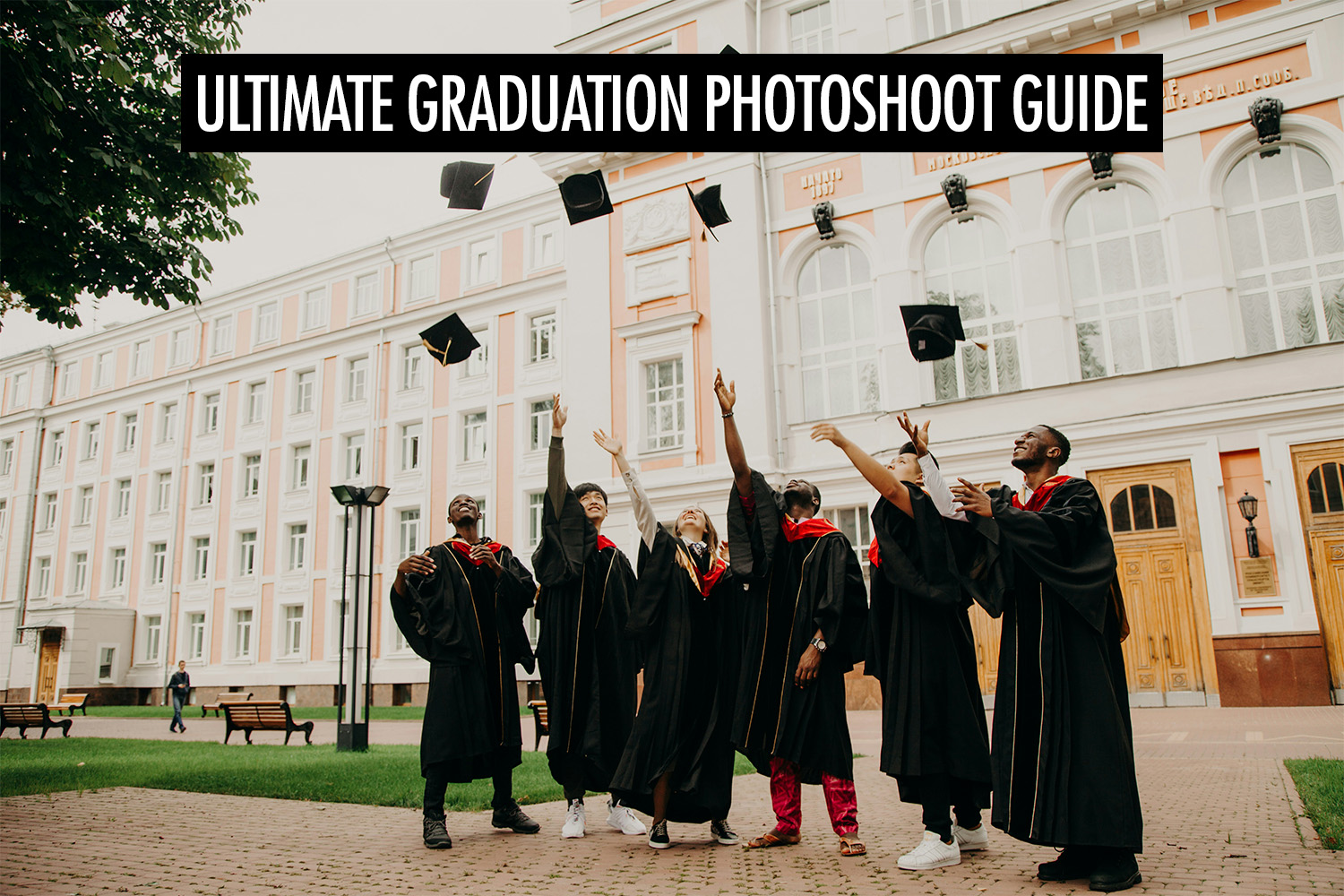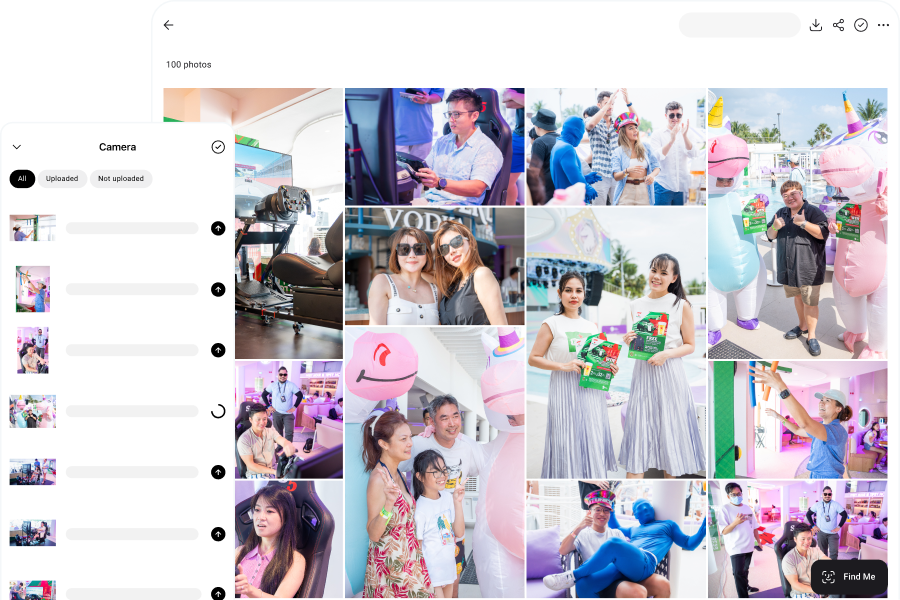Graduation day celebrates years of dedication—late nights, early mornings, and countless milestones. For college students, it marks the close of one chapter and the start of adulthood. For high school graduates, it’s the bridge between youth and independence. For kindergarteners, it’s a joyful first step into a lifetime of learning. No matter the stage, the feelings are the same: pride, excitement, and anticipation for what’s ahead.
Graduation ceremony photography turns fleeting moments into timeless keepsakes. Beyond the iconic handshake on stage, it captures the nervous smile before the walk, the embrace of a proud parent, and the laughter shared with friends. These images become emotional anchors that bring the day back to life years later, long after the cap and gown have been packed away.
In this guide, we’ll break down the essentials of graduation photography—from capturing the magic of the ceremony to creating graduation portraits that stand the test of time. You’ll discover posing ideas for both teens and kids, tips for planning family and group shots, strategies for navigating crowds and tight schedules, and advice on choosing the right gear and setups. By the end, you’ll have a complete roadmap for producing graduation photos that are not only technically flawless but also rich with emotion.
You can also find our other guides on photographing students:
- Mastering School Photography: A Complete Guide to Picture Day
- 70+ Senior Picture Ideas, Poses and Tips for Stunning Portraits
Graduation Ceremony

The convocation ceremony is the centerpiece of graduation day. It is a formal event with a clear sequence, with countless small moments that contribute to the story. As a graduation photographer, your job is to capture both the official highlights and the subtle emotional details that unfold in between.
The day often begins with the procession, which is the first glimpse family and friends have of the graduates. This is where genuine expressions emerge, like a quick wave to the crowd, a deep breath to steady nerves, or a playful exchange between classmates. Capturing these moments sets the tone and provides strong opening images for a gallery.
Once the graduates are seated, shift your attention between the stage and the audience. While speeches can be lengthy, they often give rise to moments of laughter, pride, or even quiet tears. Watch the crowd closely for these reactions. A proud smile from a mother, a tearful glance from a grandparent, or a sibling leaning in for a whisper can be just as powerful as the moment the diploma changes hands.
The walk across the stage is the climax of the convocation ceremony. Every graduate anticipates it, and your timing here is crucial. Position yourself so you can capture the handshake, the diploma, and the graduate’s expression in one frame. Shoot a short burst of images to ensure you capture both the formal handshake and the smile that follows.
Do not overlook the moments immediately after the graduate leaves the stage. Hugs, high-fives, and emotional embraces often happen before they return to their seat. These unscripted exchanges carry a raw authenticity that posed shots cannot replicate, and including them in your coverage creates a more complete visual story.
The pace of the day leaves little room for hesitation. Between the graduation ceremony, post-event greetings, and the inevitable flood of photo requests, time can disappear quickly. That’s why it’s essential to have a plan for moving through the day efficiently. Before the event begins, identify the key locations you want to photograph—the stage, certain sections of the audience, and a few scenic portrait spots—and decide on the most efficient way to move between them without losing precious minutes.
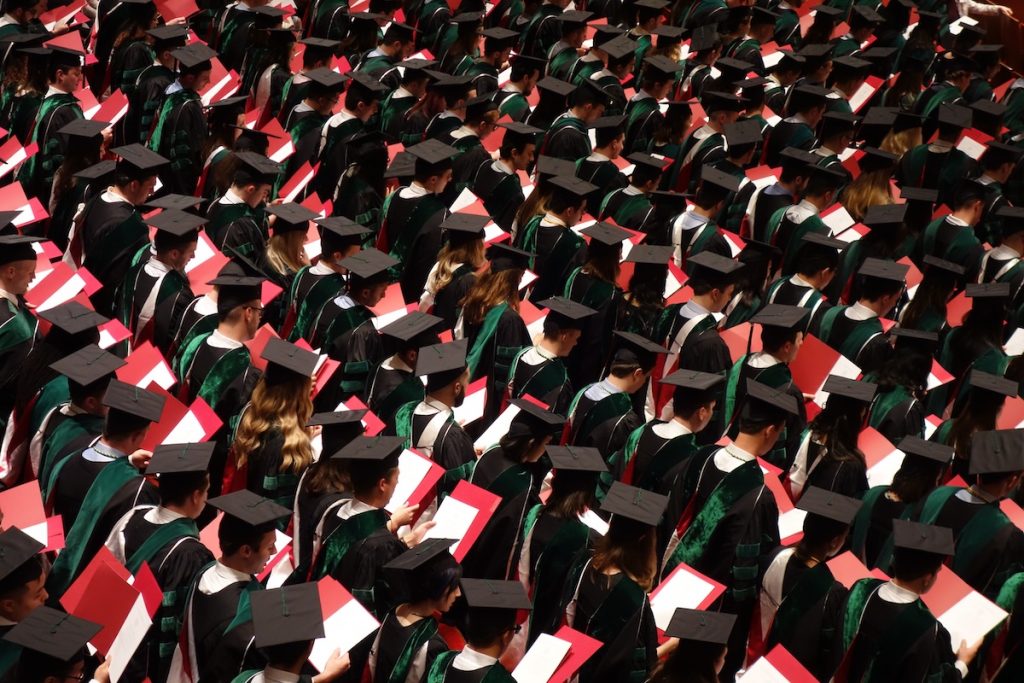
Crowds present one of the biggest challenges. Guests often lean into aisles or stand up to capture their own photos, sometimes blocking your shot. Arriving early allows you to secure unobstructed vantage points. Once the formal program ends, move swiftly to your chosen graduation portrait spots before they become crowded. Always keep two or three alternative locations in mind in case your first choice is taken.
Clear, confident communication can save valuable time. Whether you are gathering family groups or arranging classmates for a group portrait, speak in a way that is easy to hear over the noise of the crowd. In particularly loud or chaotic environments, hand gestures or physically guiding people into position can keep things moving. Maintaining a friendly but firm tone ensures you stay on schedule without making subjects feel rushed.
Work in short, efficient bursts, capturing multiple frames of each moment before moving on. This allows you to document the variety of moments without holding up the flow of the day. By balancing careful attention to detail with the need to move quickly, you can cover the entire convocation ceremony and its surrounding events without missing a beat.
In the end, success comes from being both a storyteller and a tactician. You need the creative vision to frame moments beautifully and the logistical skills to anticipate movement, navigate crowds, and adapt instantly. When you bring both to the graduation ceremony, you not only capture the key milestones but also preserve the fleeting expressions and gestures that make the day unforgettable.
Graduation Photoshoot
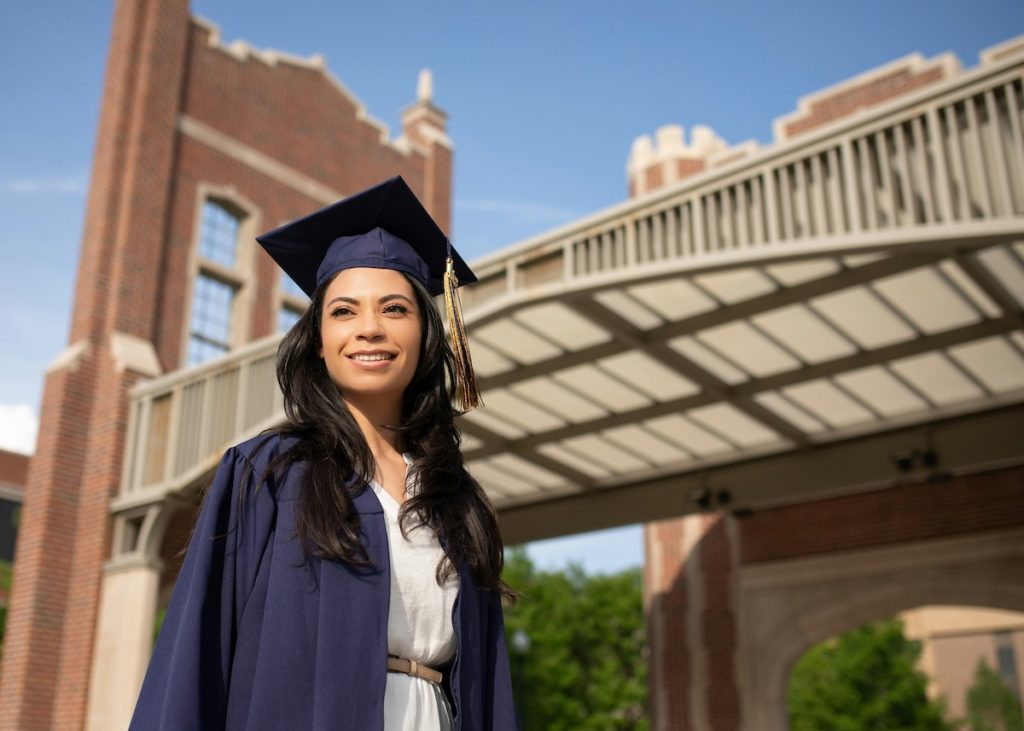
A graduation photoshoot can take place either before or after the ceremony, and each timing has its advantages. Shooting beforehand offers calmer conditions and access to key locations before they become crowded. It also allows the graduate to look fresh and composed before the emotional whirlwind of the event begins. Shooting afterward captures the excitement and relief of the moment, when formalities are over and genuine joy takes center stage. Regardless, the goal is to create a set of portraits that balances the tradition of convocation with the personality of the graduate.
Lighting is crucial. If you are outdoors, position the graduate so the light falls evenly on their face, avoiding harsh shadows from the cap’s brim. If indoors, use a portable light source or reflector to create even illumination. The goal is to maintain clarity and detail, especially in the face and gown, without losing the sense of place.
Interaction also adds depth. Ask the graduate to laugh, look away thoughtfully, or walk slowly toward the camera. These subtle movements create a series of natural, expressive shots that feel less posed and more authentic.
Finally, remember that this moment belongs to the graduate. Let them have input on poses, props, or locations. If they want to show off decorated caps, academic cords, or unique shoes, include these details. Personal touches make the images a better reflection of the graduate’s personality and journey.
Family and Group Graduation Portraits
Graduation is rarely a solo celebration. Family members, friends, and classmates all play a role in the journey, and capturing these connections is just as important as photographing the graduate alone. Group photos add context and emotion, turning the day into a shared memory.
Family Portraits
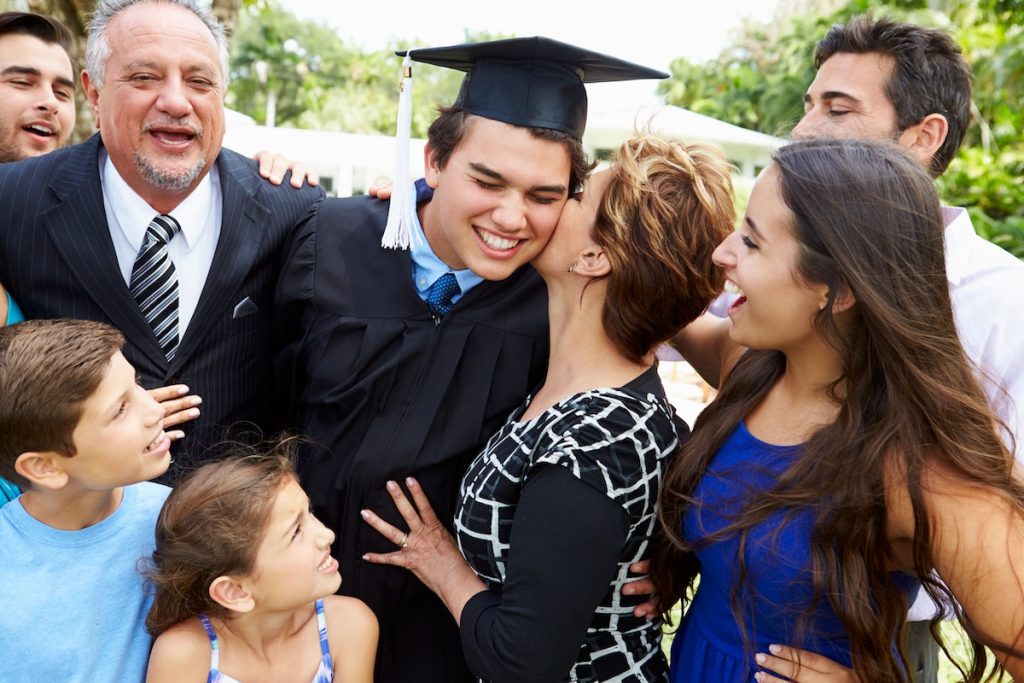
Begin with immediate family. Parents, siblings, and grandparents often travel or take time off work to be present, so give them priority. Position the graduate in the center, flanked by family members, and encourage physical closeness such as arms around shoulders or hands linked. These gestures convey warmth and pride.
If possible, create variations. Shoot one formal, front-facing arrangement, then loosen it up for more casual frames where family members laugh or lean in for a hug. Including multiple expressions ensures that everyone has at least one image they connect with emotionally. A proud grandparent holding the graduate’s hand or a younger sibling trying on the cap makes for images that tell a deeper family story.
Group Photos With Friends
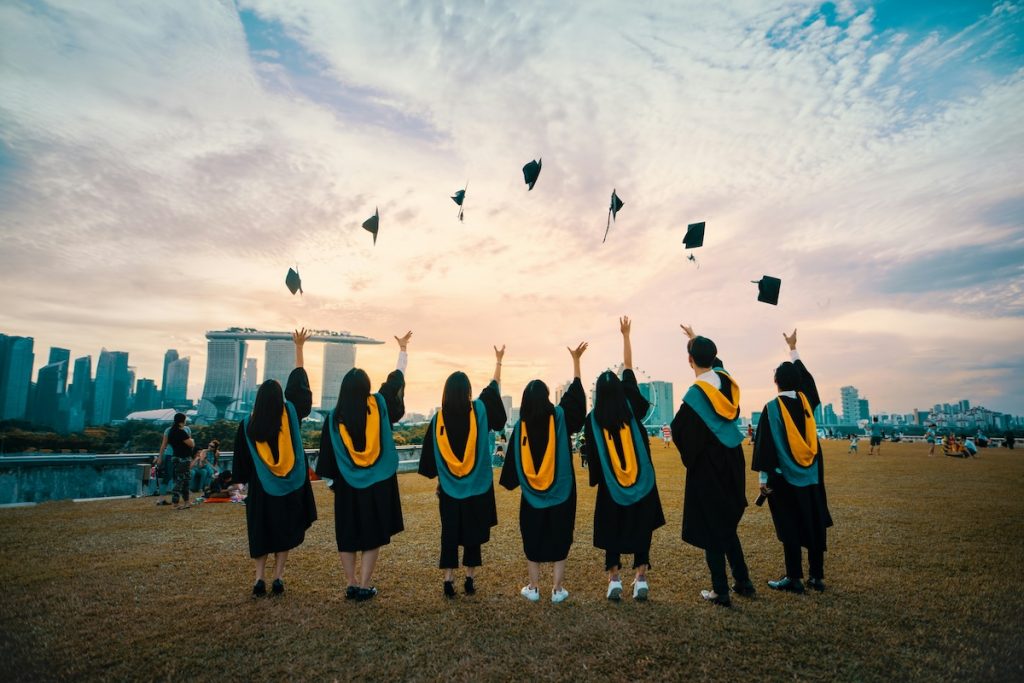
Friends, especially classmates, share a unique bond forged through shared experiences. Capture them in a way that reflects their energy. This could be a tightly packed huddle, a walking-toward-the-camera shot, or the classic cap toss done in unison.
Encourage playful interactions. Have them cheer, hold diplomas high, or recreate an inside joke. These images will feel authentic and will be treasured for the way they preserve the graduate’s social world at that time.
Managing Large Groups
When photographing extended family or entire classes, positioning and communication are key. Arrange taller individuals at the back, shorter in front, and keep rows slightly staggered to avoid blocked faces. Use a strong, clear voice to direct everyone quickly, as large groups can lose focus.
For wide shots, ensure your lens choice provides enough coverage without distortion. If space allows, step back and use a longer focal length to keep proportions flattering.
70 Graduation Photo Ideas and Poses
Good posing turns a standard graduation photo into a striking, memorable portrait. Whether you are working with confident teens or energetic kindergarteners, the key is to guide them in a way that feels natural and reflects their personality.
Encourage small adjustments between shots, such as shifting weight to one leg, holding the gown slightly open to show their outfit, or interacting with a prop like a bouquet or honor cords. When photographing teens, keep energy high and give positive feedback so they feel comfortable and assured.
Photographing younger children requires a gentler approach and more flexibility. Attention spans are short, so keep poses simple and sessions quick. Give simple, clear directions and use playful prompts like “Show me your biggest smile” or “Pretend you just won a race.” This keeps the mood light and produces authentic expressions.
Classic Cap and Gown
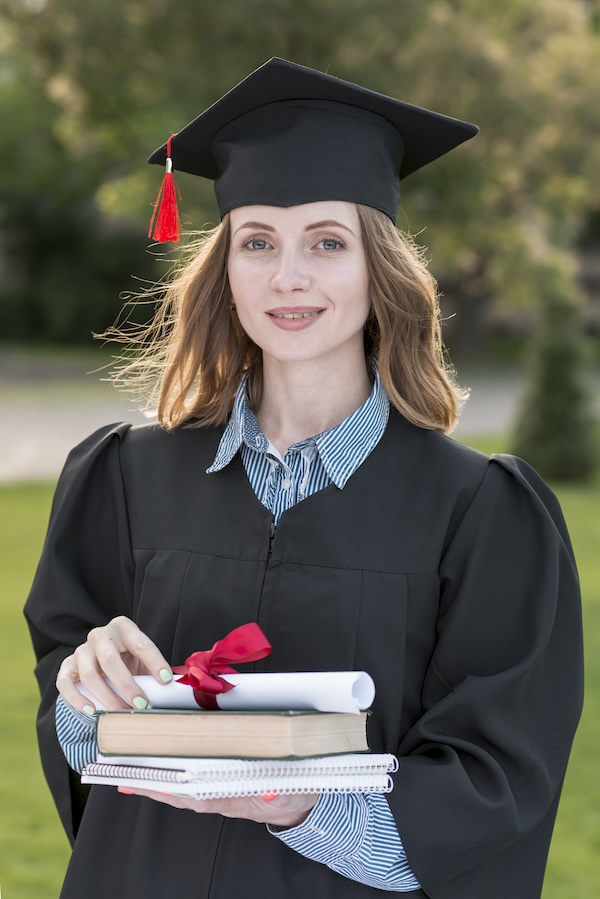
Have the graduate stand tall facing the camera, holding the diploma neatly in hand. Keep their posture confident and expression composed to create a timeless, formal portrait. This classic graduation photo pose highlights their achievement and works perfectly for yearbook photos, announcements, or framed prints.
Over-the-Shoulder Glance
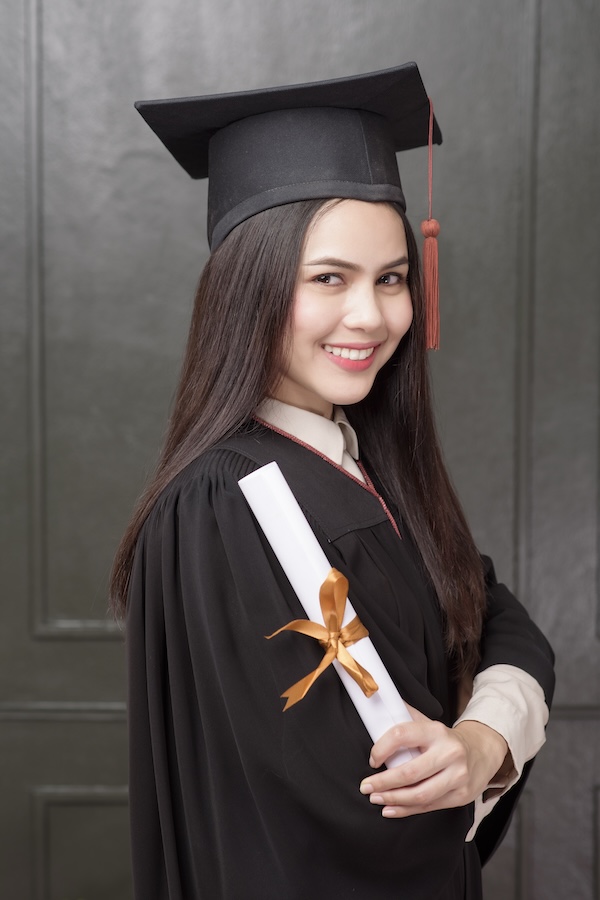
Capture a half-body shot of the graduate indoors as they turn their head back toward the camera with a relaxed expression. The tassel is visible, adding a classic graduation detail. This simple yet elegant pose works well for portraits, giving a polished and personal touch to the image.
Walking Shots

Have the graduate take slow, natural steps toward the camera with either a bright smile or a proud, confident expression. This graduation photo idea creates a lively, engaging image that conveys excitement and accomplishment. It works well in hallways, outdoor paths, or any setting with a clear walkway.
Cap Toss
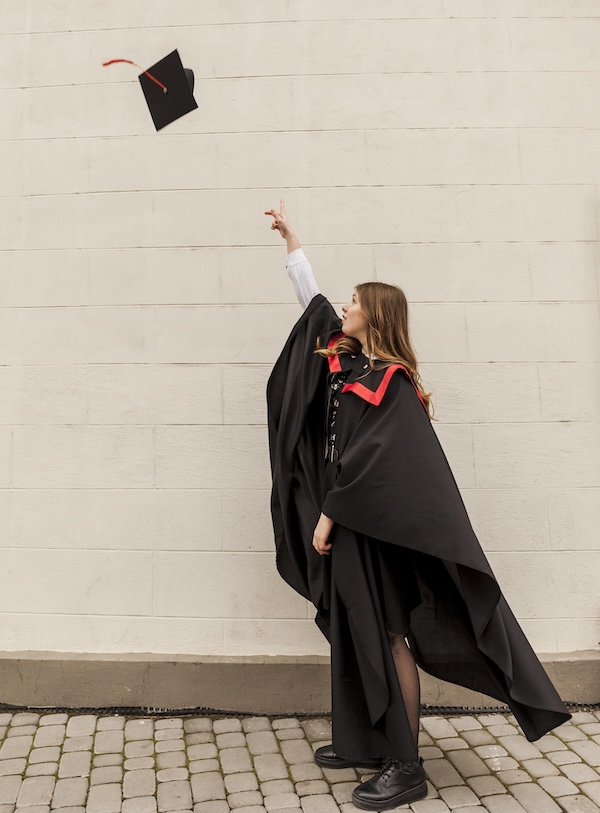
Photograph the graduate mid-throw to capture the cap at the peak of its flight. Take multiple shots in quick succession to get the perfect airborne moment. This classic idea is full of energy and celebration, making it a must-have for graduation portraits.
Seated on Campus Steps

Have the graduates sit on campus steps with their gown draped naturally, hands resting casually on their knees. Ask them to look slightly off-camera for a relaxed, thoughtful feel. This graduation photo idea blends formality with ease and works beautifully against classic school architecture.
Leaning
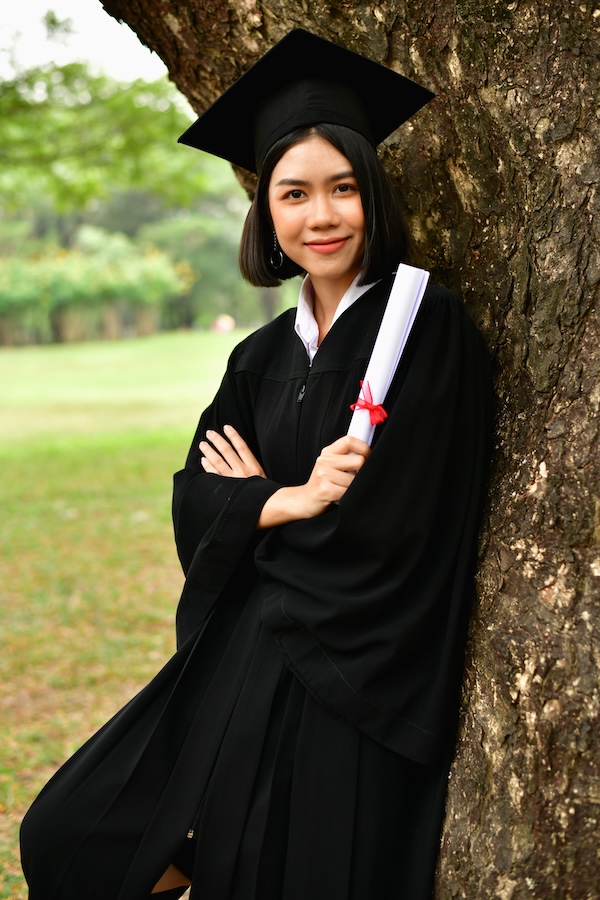
Have the graduate lean against a wall, railing, or pillar with one foot propped up. They can cross their arms or hold the diploma casually for a confident yet relaxed look. This pose works well both indoors and outdoors, adding a modern, effortless vibe to the graduation portrait.
Open Gown

Have the graduate hold their gown slightly open to reveal the outfit underneath while giving a lighthearted grin. This pose highlights their personal style and adds a fun, casual touch to the traditional graduation look. It works well in both studio and outdoor settings.
Close-Up With Tassel

Capture a portrait of the graduate with their head slightly tilted and the tassel positioned to the side of their face. This simple pose focuses on key graduation details and expressions, creating an elegant and memorable close-up shot.
Victory Pose

Have the graduate raise one arm proudly in the air while holding the diploma tightly in the other hand. This energetic pose captures the excitement and triumph of graduation, making it perfect for both candid and posed shots.
Meaningful Location
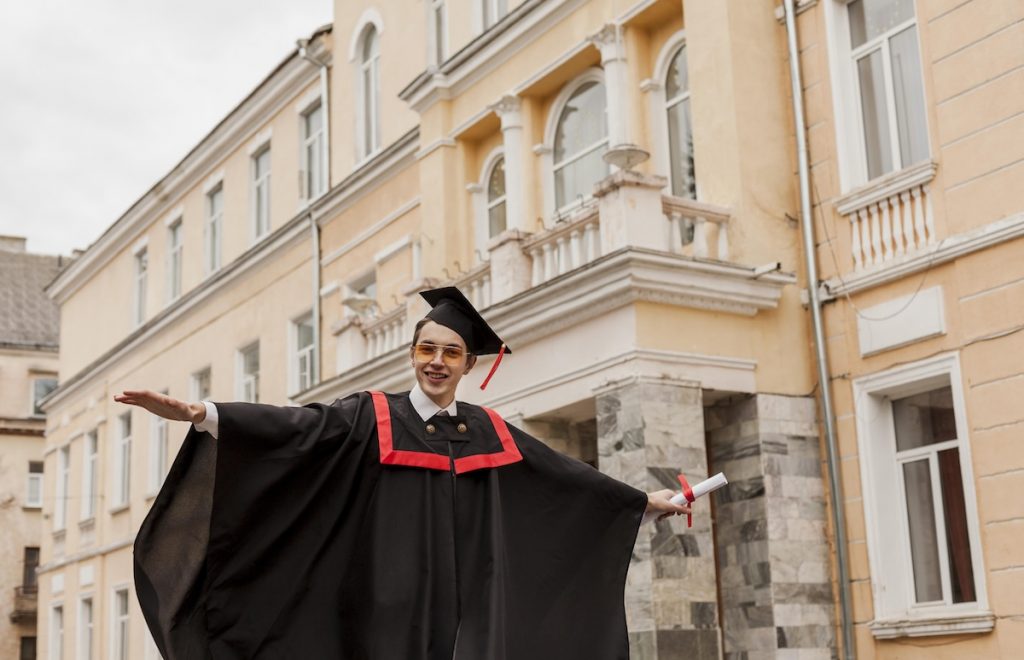
Place the graduate in front of a significant campus landmark such as a school sign, clock tower, or their favorite study spot. Have them stand confidently, either looking at the camera or gazing proudly at the location. This graduation photo idea adds personal significance to the portrait, making it a lasting reminder of their time on campus.
Group Photo

Gather the graduates together and have them stand close, smiling proudly while holding their diplomas. Capture the joyful energy of the moment as they celebrate their achievement side by side. This graduation photo pose works well in open spaces or in front of meaningful school landmarks, creating a timeless keepsake of their shared accomplishment.
Confetti Celebration

Have the graduates pose or celebrate together while colorful confetti falls around them. Capture their genuine reactions such as laughs, cheers, or playful gestures as the confetti fills the frame. This energetic idea adds a festive, dynamic touch to graduation portraits, making the moment feel truly special.
Proud Moment
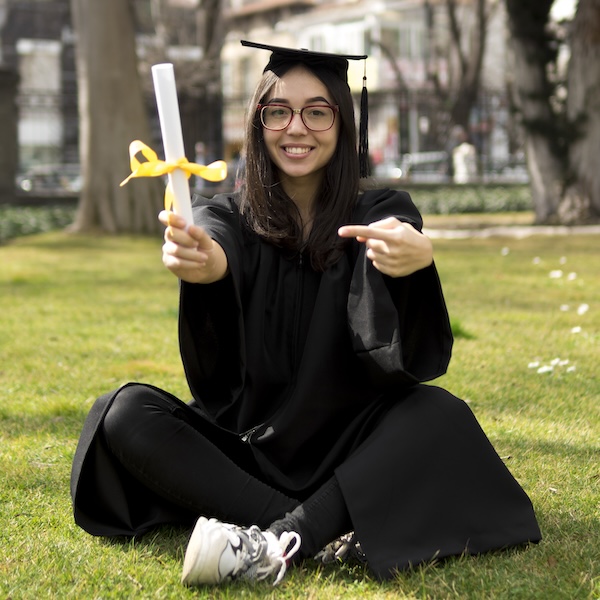
Have the graduates sit casually on the grass outdoors, holding their diploma and pointing at it with big, joyful smiles. This relaxed pose captures their excitement and pride in a natural setting, creating a warm and memorable graduation photo.
Joyful Celebration
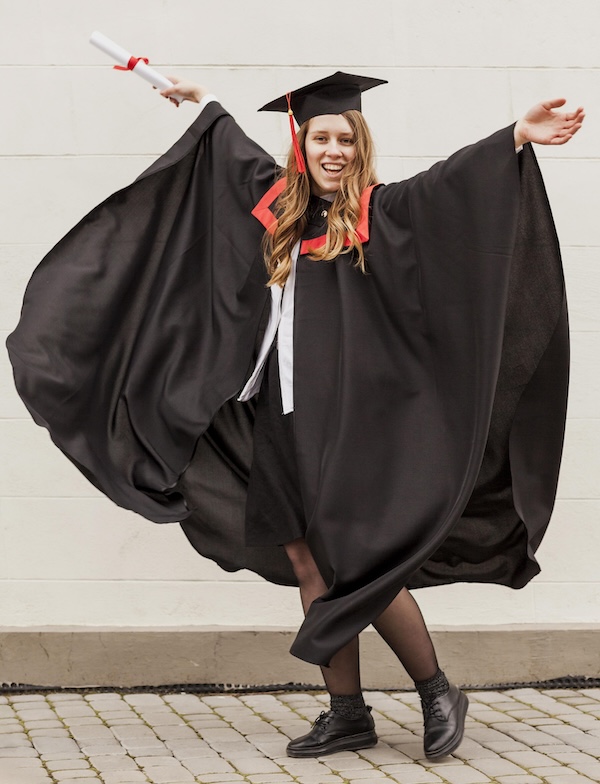
Have the graduate spread their arms wide and flash a big, genuine smile while proudly holding their diploma. This lighthearted pose radiates happiness and excitement, making it perfect for capturing the pure joy of graduation day.
Playful Backdrop
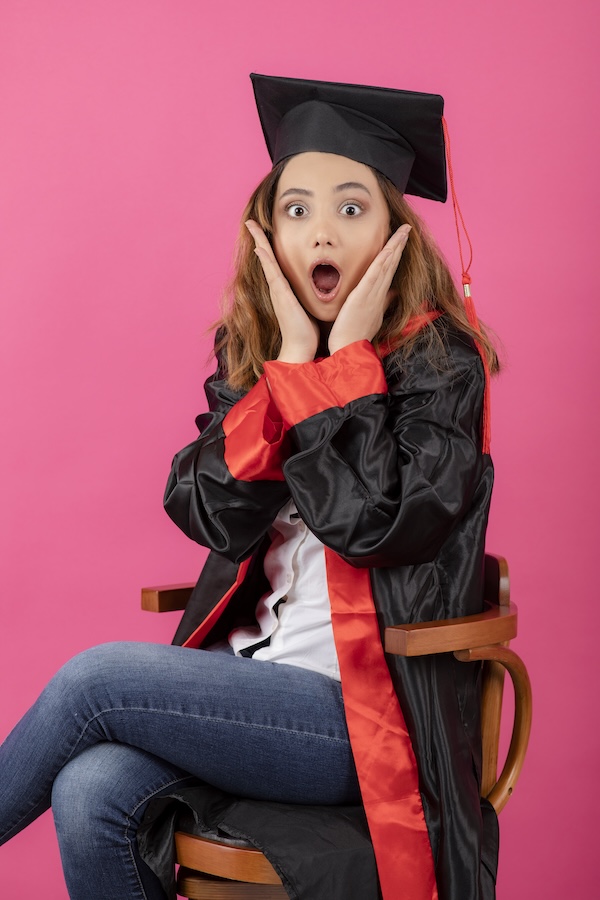
Use a bright, colorful background to create a lively atmosphere that encourages fun and energetic poses. Have the graduate experiment with playful expressions, dynamic stances, or props to match the vibrant setting. This graduation photo idea adds a modern, cheerful twist to traditional portraits.
Prop Party Shot
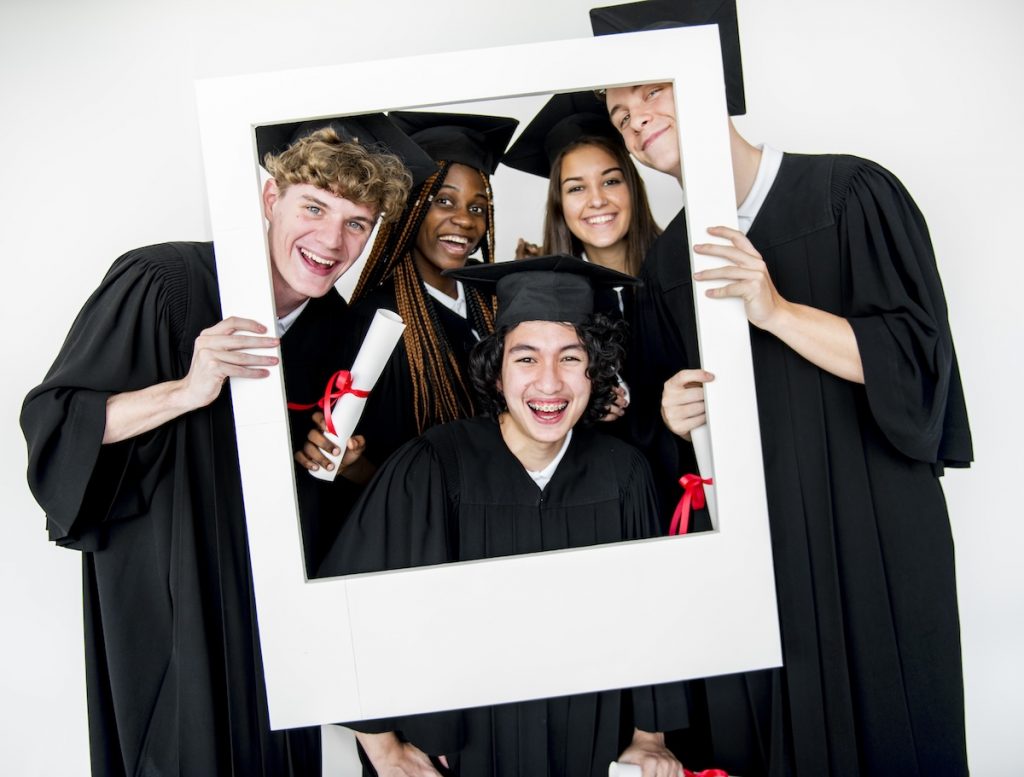
Gather the graduates indoors and give them fun props like Polaroid frames, oversized glasses, confetti poppers, or playful signs. Have them pose together with cheerful expressions, creating a lively and memorable group photo. This graduation photo idea adds a festive, lighthearted touch to the celebration.
Timeless Portrait
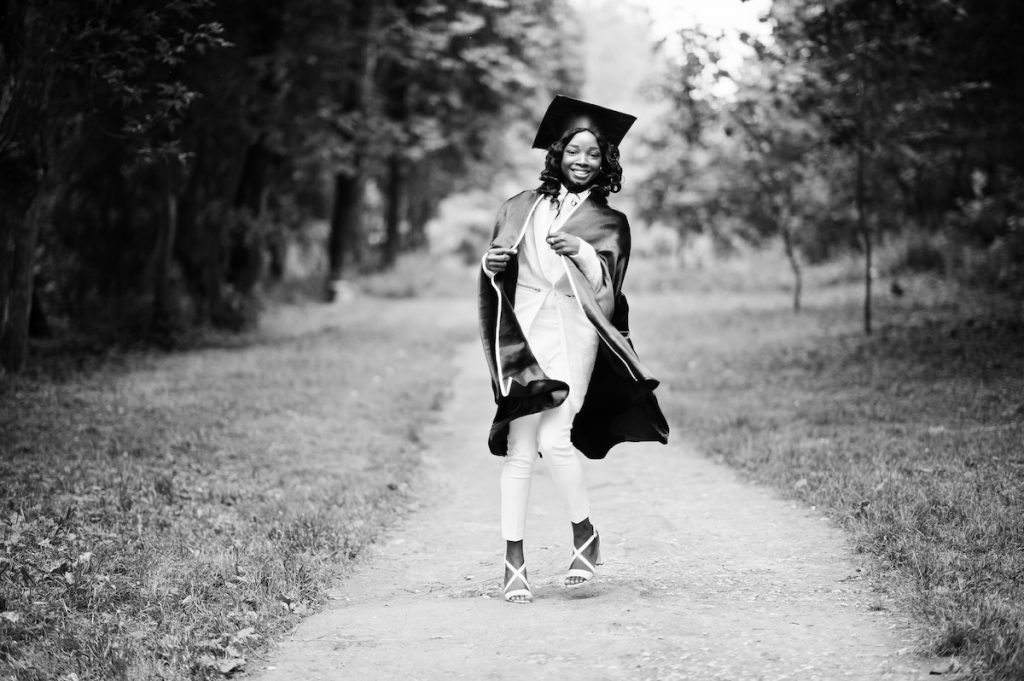
Capture the graduate outdoors in a black-and-white shot that emphasizes simplicity and genuine emotion. Focus on clean composition and natural expressions to create a classic, enduring image that will remain meaningful for years to come.
Freedom Pose
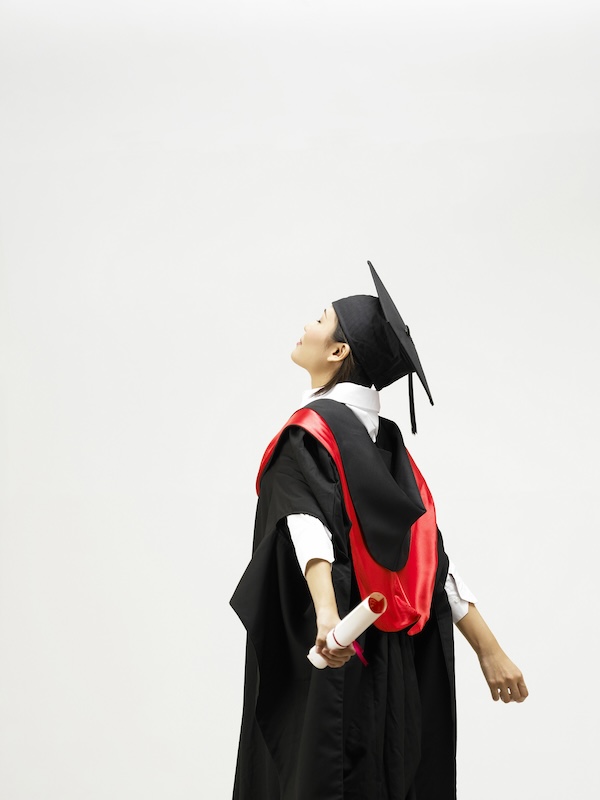
Have the graduate stand in a calm outdoor setting, tilting their head up toward the sky with eyes closed and a gentle smile. This serene graduation photo pose conveys a sense of relief, gratitude, and optimism, creating a beautifully symbolic portrait.
Trumpet Pose
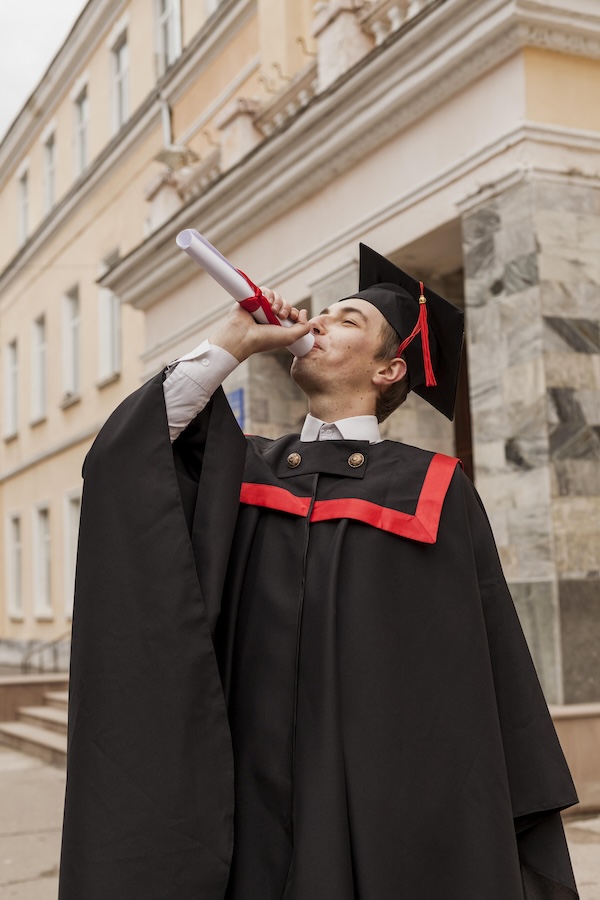
Have the graduate hold their diploma like a trumpet and pretend to play it, adding a playful twist to the portrait. This fun and creative photoshoot idea brings out their personality and works well in both studio and outdoor settings, making the shot lighthearted and memorable.
Overhead Perspective
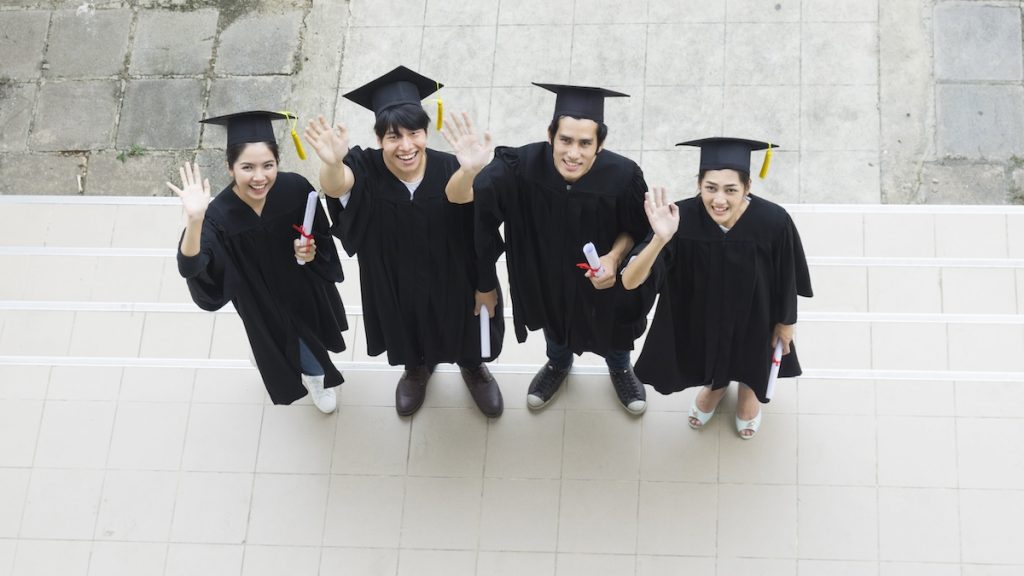
Capture the scene from a high angle, such as a balcony or staircase, looking down on the graduates below. Arrange them in a fun formation or let them interact naturally for a lively, dynamic shot. This perspective adds visual interest and showcases the group or individual in a unique way.
Celebration Flat Lay
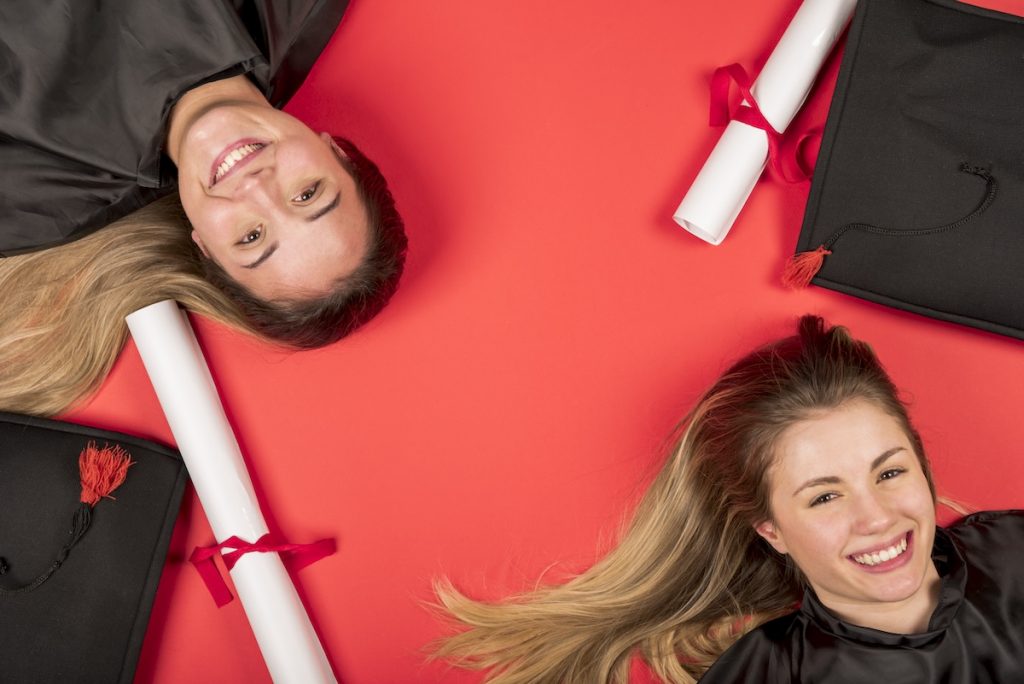
Take a top-down shot of graduates lying on the ground with their caps and diplomas arranged neatly beside them. Encourage relaxed poses and joyful expressions to create a fun, creative composition. This creative graduation photoshoot idea turns a simple moment into a visually striking and memorable photo.
Selfie
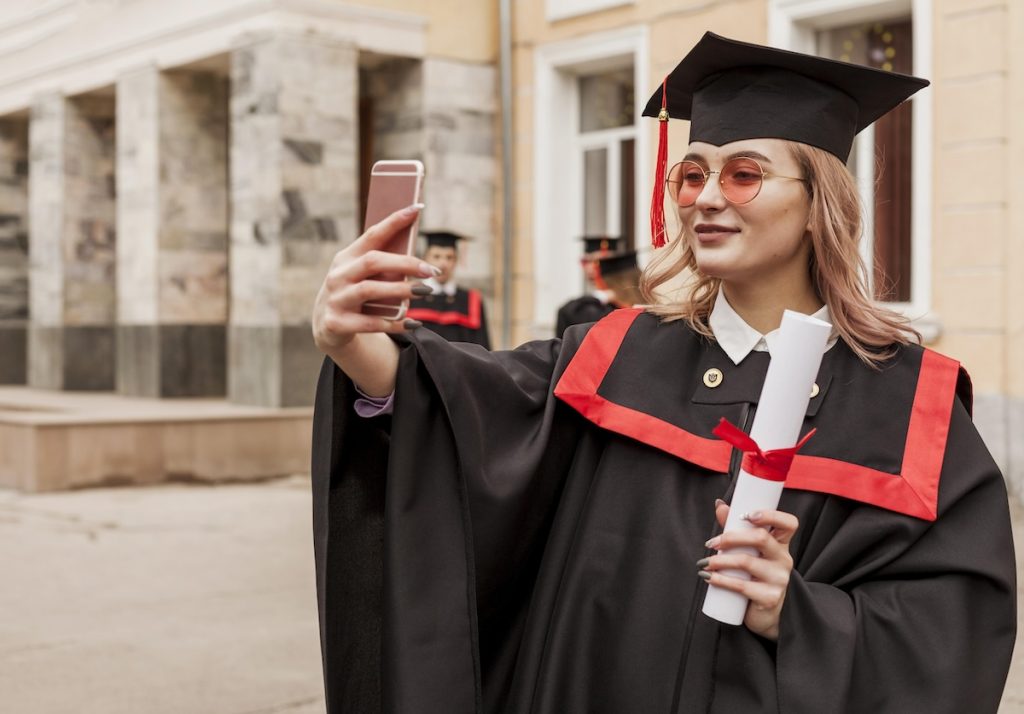
Have the graduate hold their phone up and take a selfie in the foreground while other graduates in the background laugh, pose, or strike playful actions. This modern and fun graduation pose captures the celebratory energy of the group, creating a candid and relatable moment.
Confetti Blow
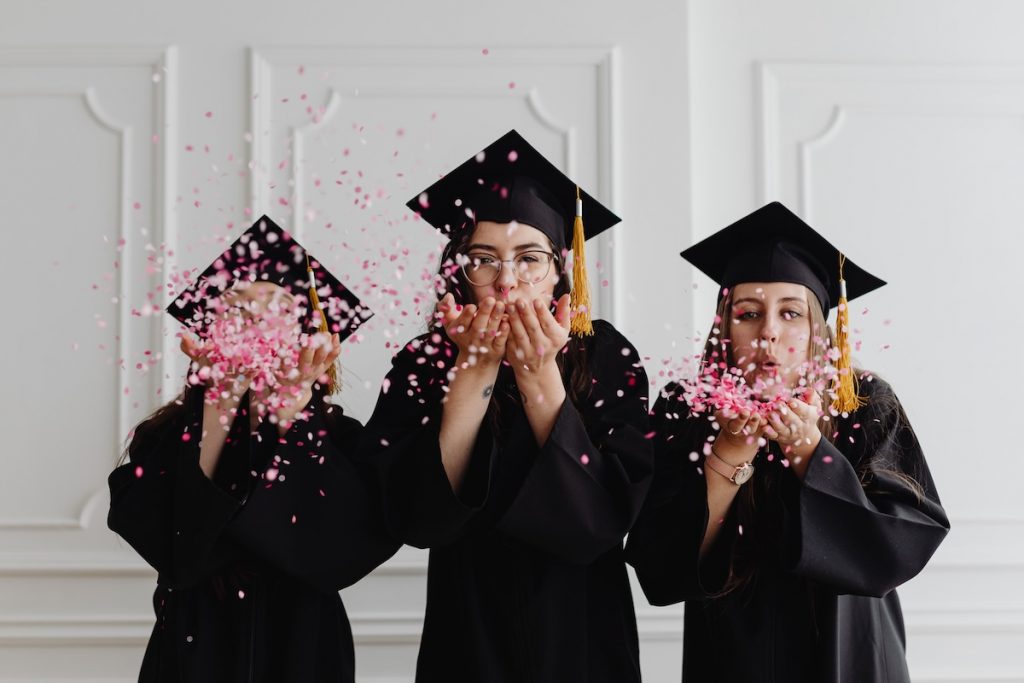
Have the graduates gather a handful of confetti and blow it toward the camera, creating a burst of color and movement in the frame. Capture the moment mid-blow to highlight their joyful expressions and the playful energy of the celebration. This creative photoshoot pose adds a festive, dynamic touch to the photos.
Dreams Come True
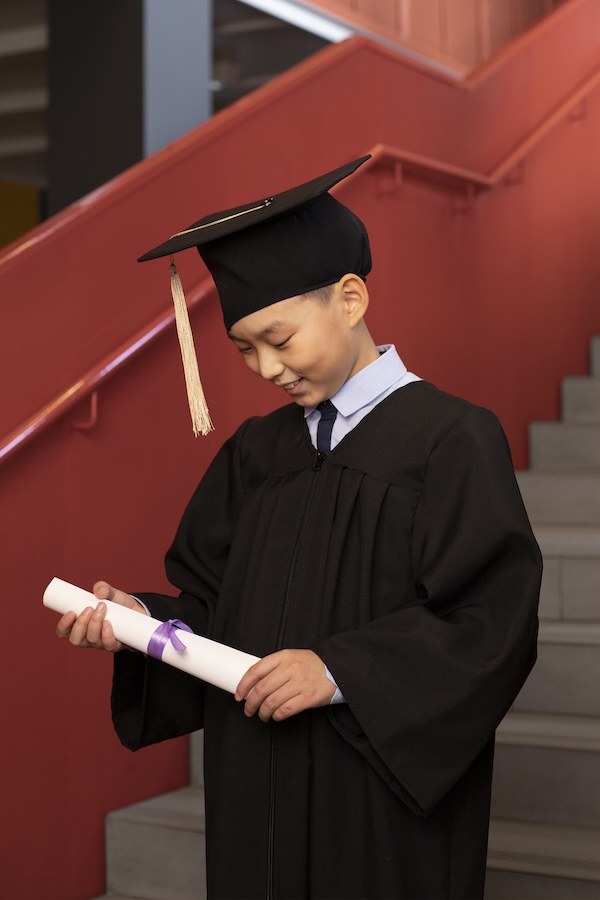
Have the graduate hold their certificate and look at it with a sense of awe and wonder, as if they can’t quite believe the moment is real. This heartfelt pose beautifully captures the pride and emotion of their achievement, making for a powerful and memorable graduation portrait.
Study Squad
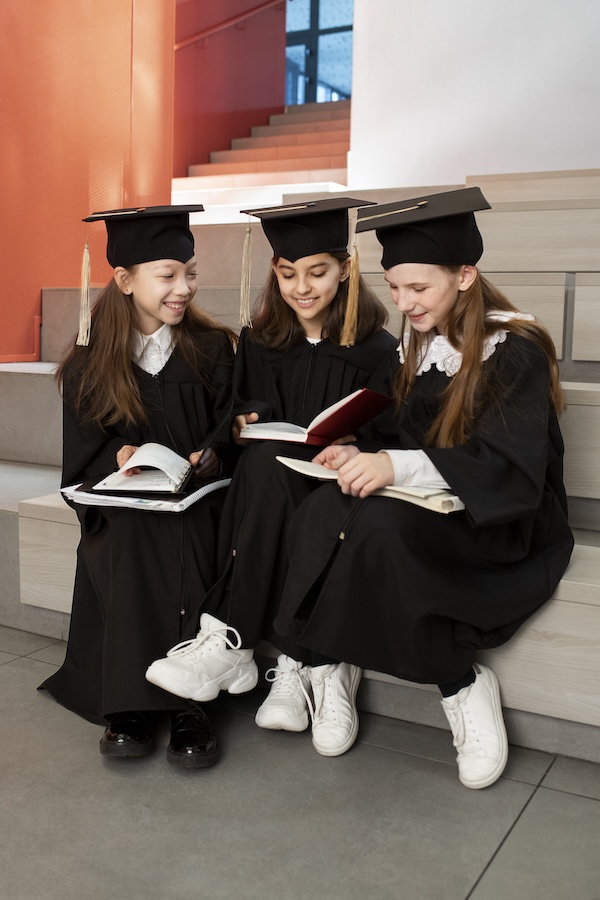
Gather a group of graduates on a staircase and have them sit close together, each holding a book as if they’re studying or sharing notes. Encourage natural interactions, like laughing or pointing at the pages, to create a warm and nostalgic scene that reflects their shared journey.
Bright Smile
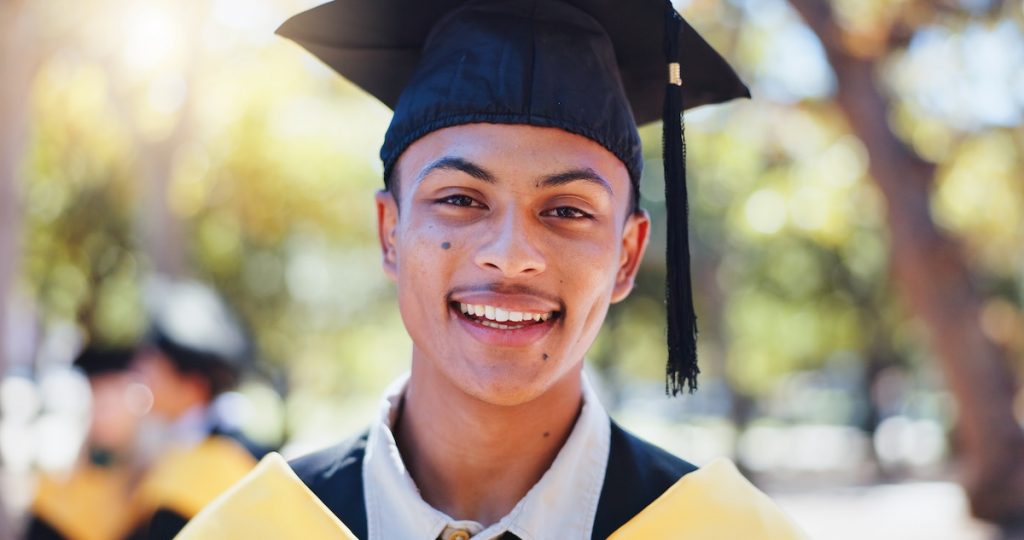
Capture a close-up portrait that focuses on the graduate’s radiant smile and joyful expression. This simple yet powerful graduation photo idea highlights genuine happiness and pride, creating a timeless image that perfectly reflects the spirit of graduation day.
Studio Laughs
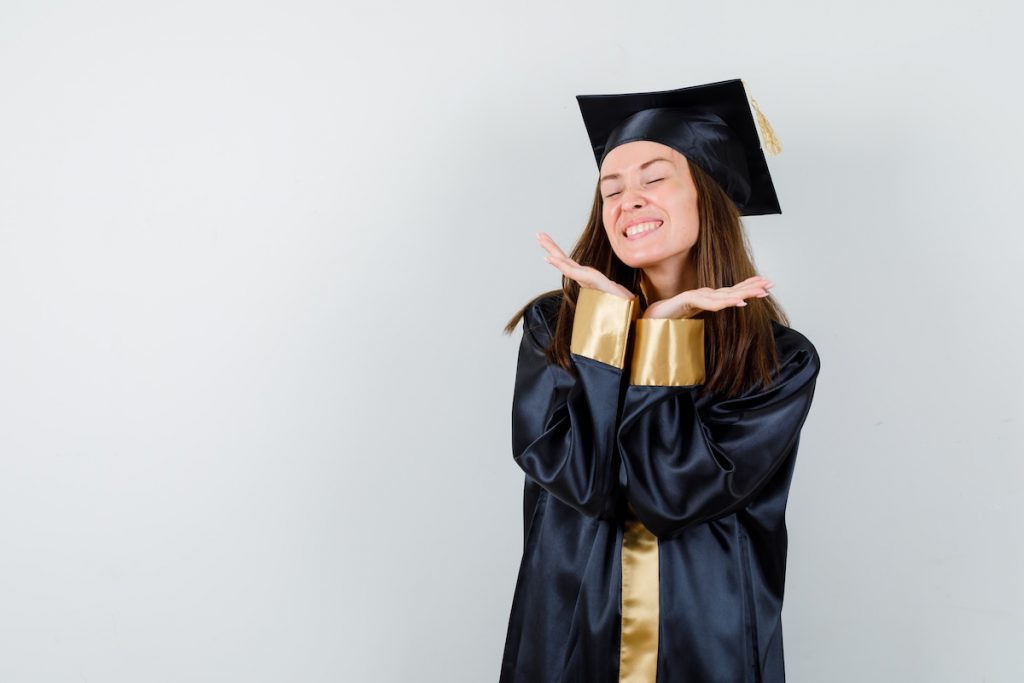
In a studio setting, have the graduate strike a funny or exaggerated pose, whether it’s pulling a goofy face, taking on a playful stance, or using props in a humorous way. This lighthearted idea captures their personality and adds a fun twist to traditional graduation portraits.
Side Profile
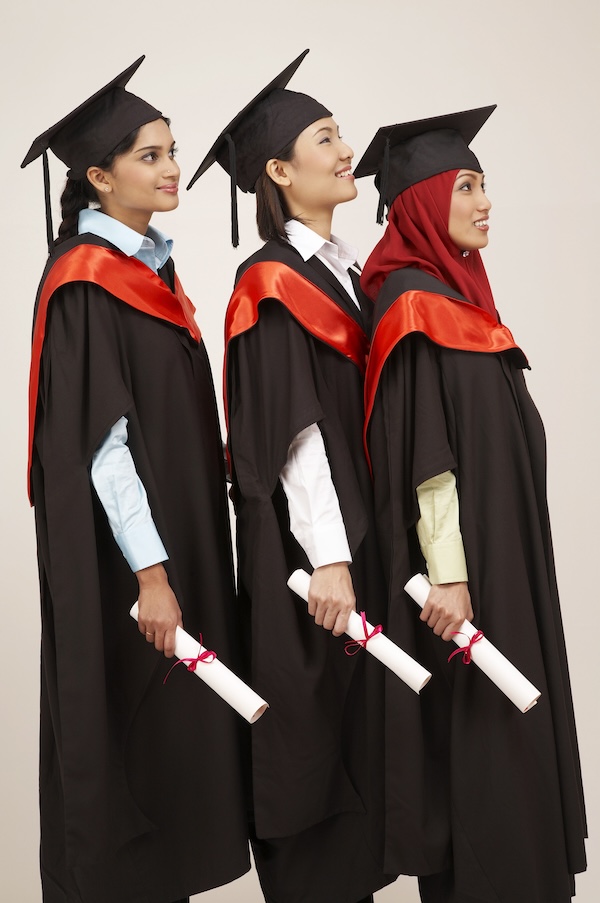
Capture an elegant indoor portrait of the graduate from the side. Focus on clean lines, soft lighting, and natural posture to highlight their features and graduation attire. This simple yet refined photoshoot pose adds a timeless and sophisticated touch to the photo collection.
Classic Portrait
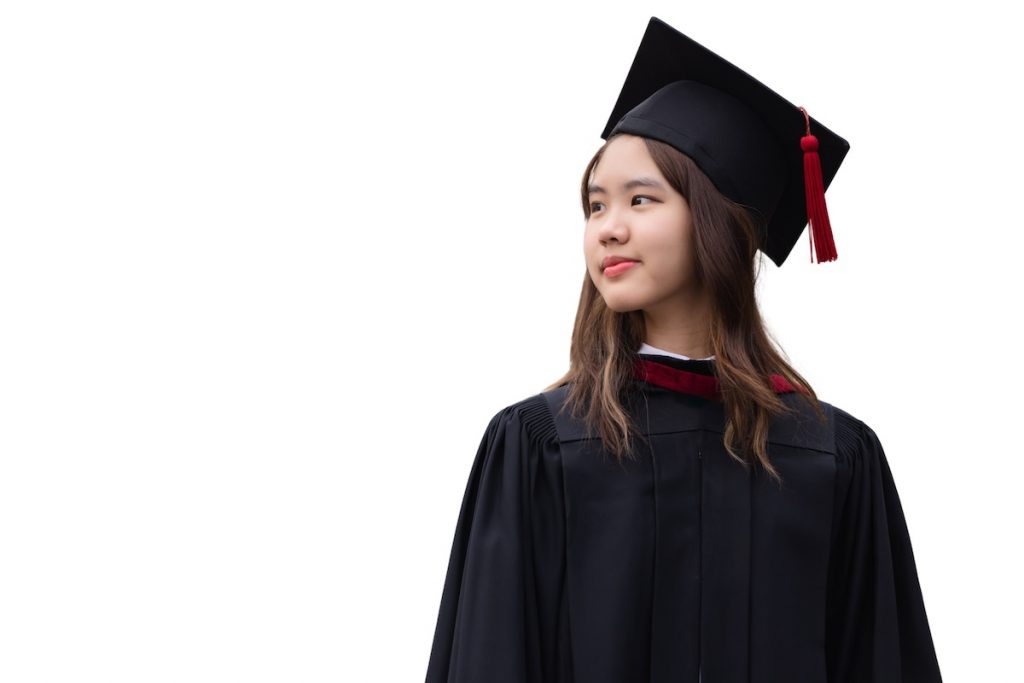
Photograph the graduate against a plain white background, keeping the composition clean and minimal. Focus on their expression and attire to create a timeless, polished portrait that highlights them as the center of attention.
Playful Peek
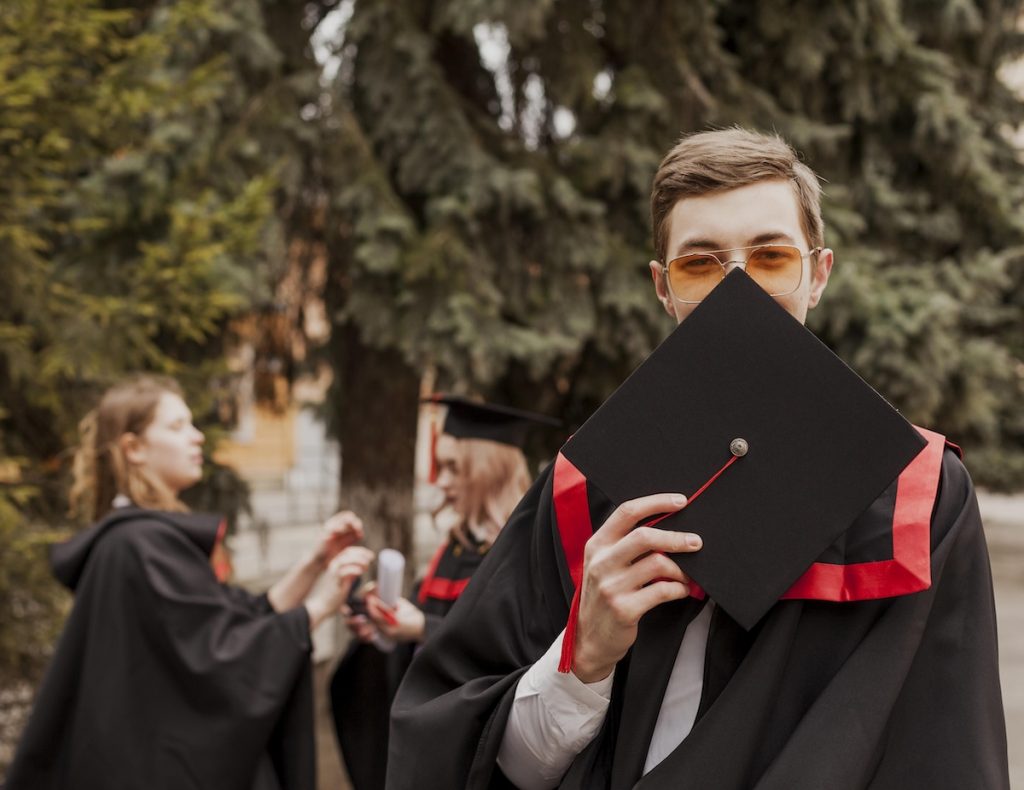
Capture a lighthearted moment by having the graduate hold their cap and peek out cheekily from behind it. In the background, other graduates can be seen adjusting their caps or gowns, adding a sense of candid pre-ceremony excitement. This idea creates a fun and dynamic layered composition that highlights both personality and the shared graduation experience.
Wefie
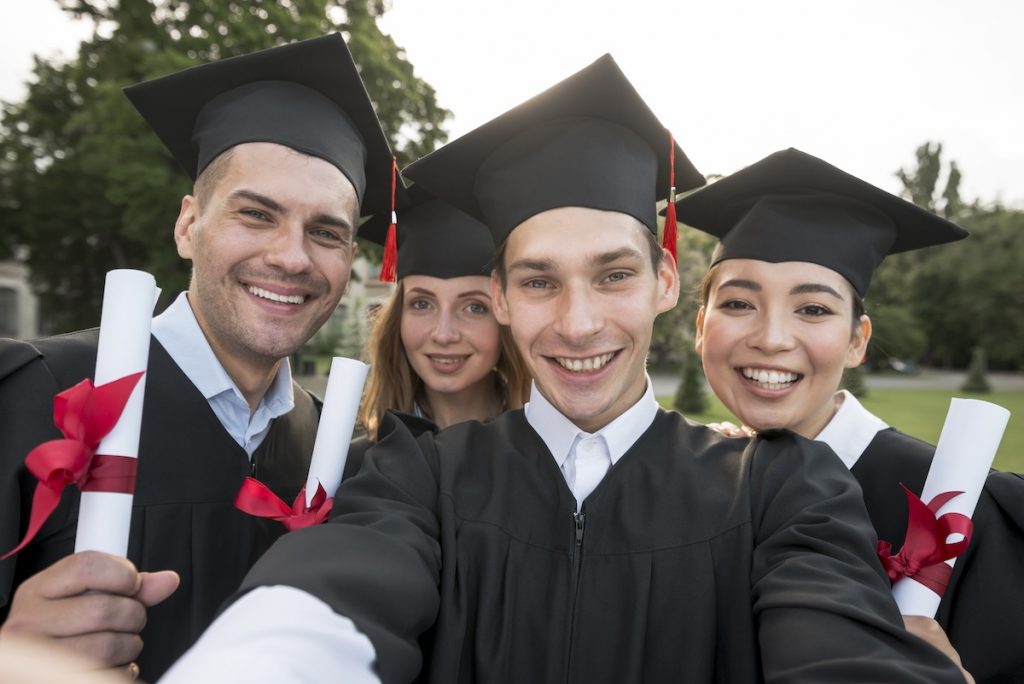
Create a fun and spontaneous scene by having one graduate stretch their arm forward as if holding an imaginary camera, while everyone else gathers close, laughing and striking playful poses. This photoshoot idea captures the joyful, carefree energy of graduation day, making it look like a candid moment among close friends.
Joyful Descent
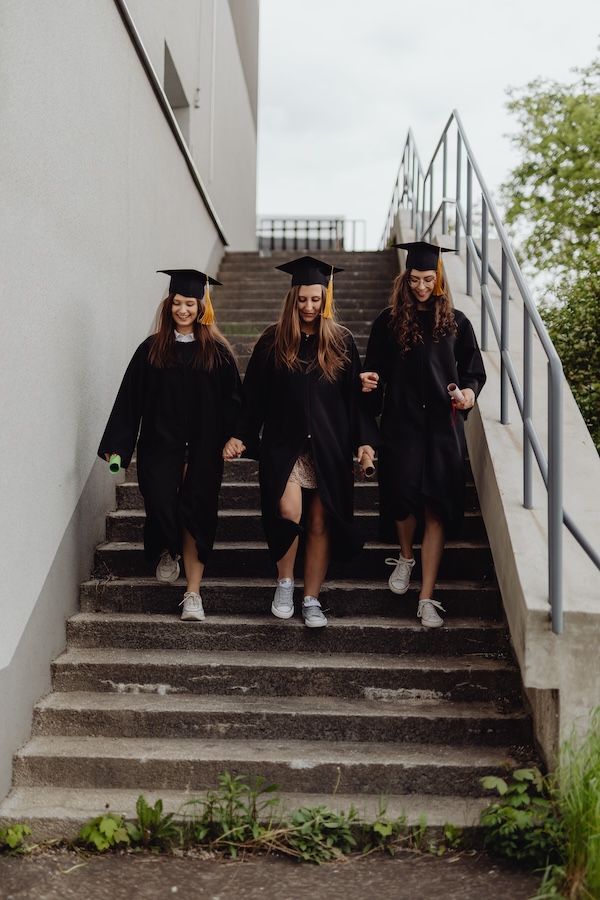
Capture a dynamic and lighthearted moment as the graduates walk down the stairs together, laughing naturally and looking away from the camera. This idea creates a sense of movement and shared excitement, perfectly reflecting the celebratory spirit of graduation day.
Seated Cap Toss
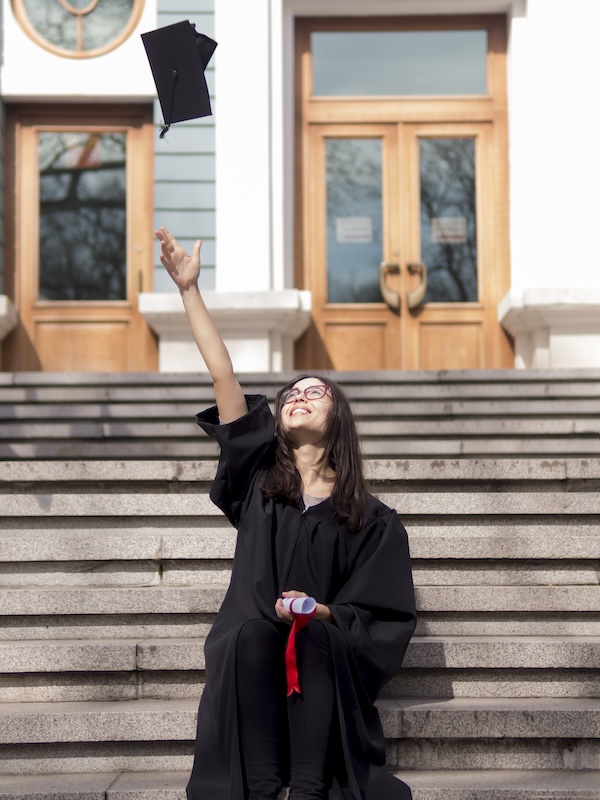
A fun and festive shot where graduates sit on the stairs, tossing their caps high into the air. This graduation photo pose captures the joy and energy of the moment while keeping the composition structured, making it perfect for both candid and posed variations.
Golden Glow
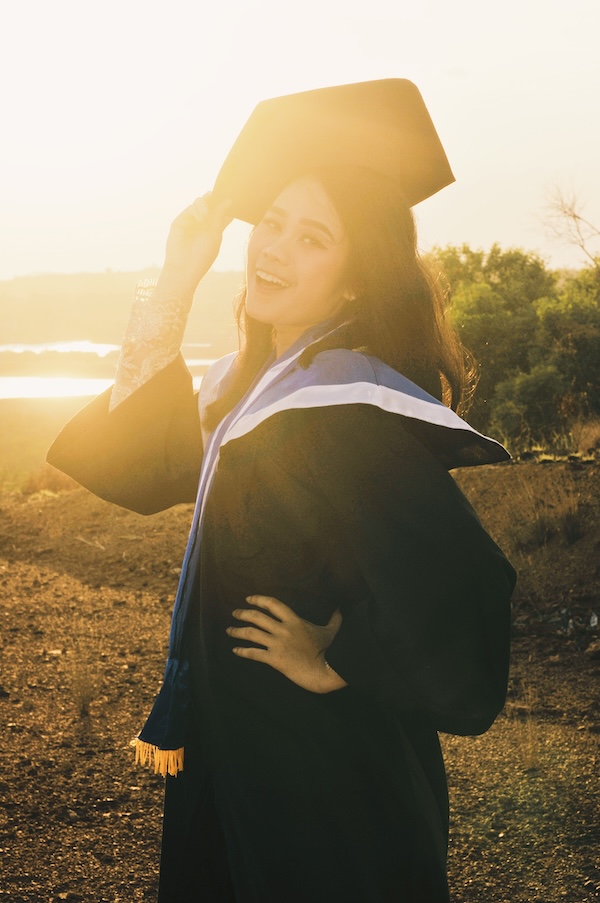
A captivating outdoor portrait captured during golden hour, when the soft, warm sunlight bathes the scene in a golden glow. The gentle tones accentuate the graduate’s features and outfit, creating a radiant, timeless image that feels natural and celebratory.
Crowning Moment
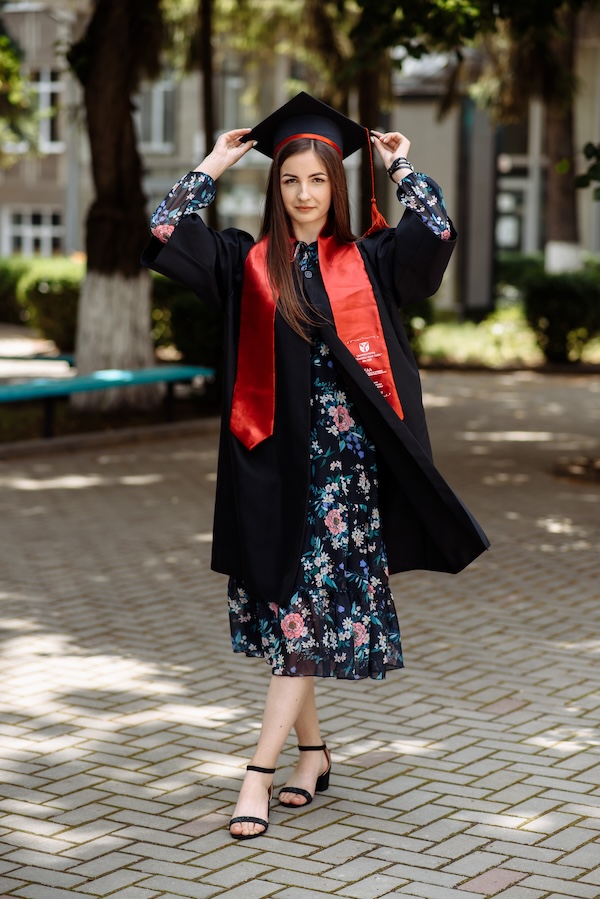
A proud pose where the graduate stands tall while holding the cap on their head with both hands, symbolizing the peak of their academic journey and the moment their hard work pays off.
Sunset Silhouette
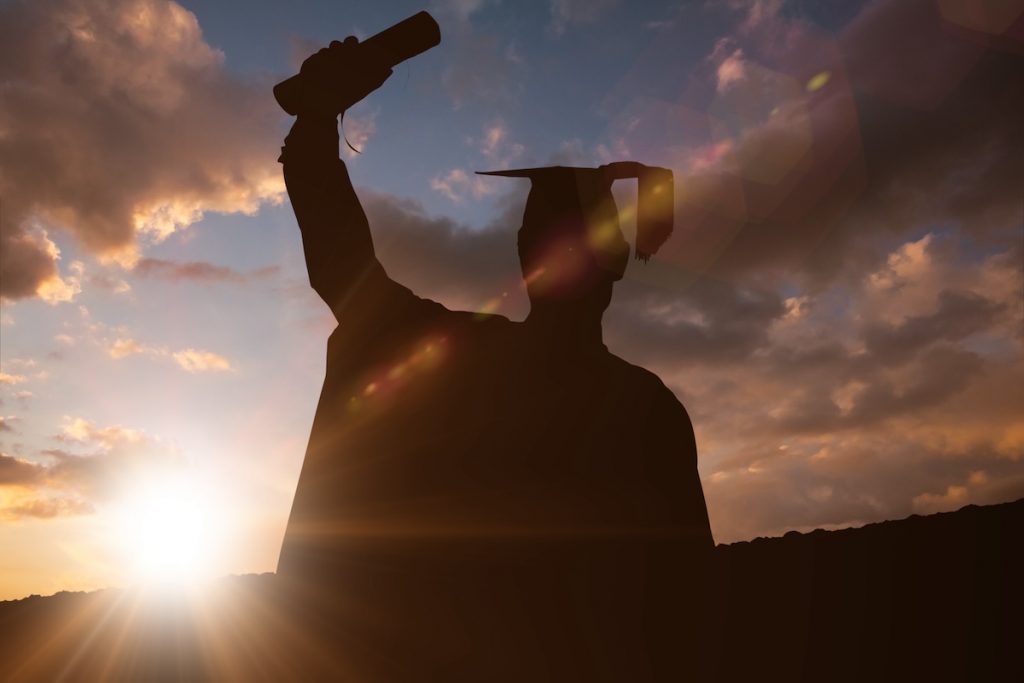
A dramatic outdoor graduation portrait captured during sunset, where the graduate’s silhouette stands out boldly against the vibrant sky. The glowing hues of the setting sun create a striking contrast, giving the photo a timeless and cinematic quality. This graduation photo idea highlights both the beauty of the moment and the sense of accomplishment it represents.
Cityscape
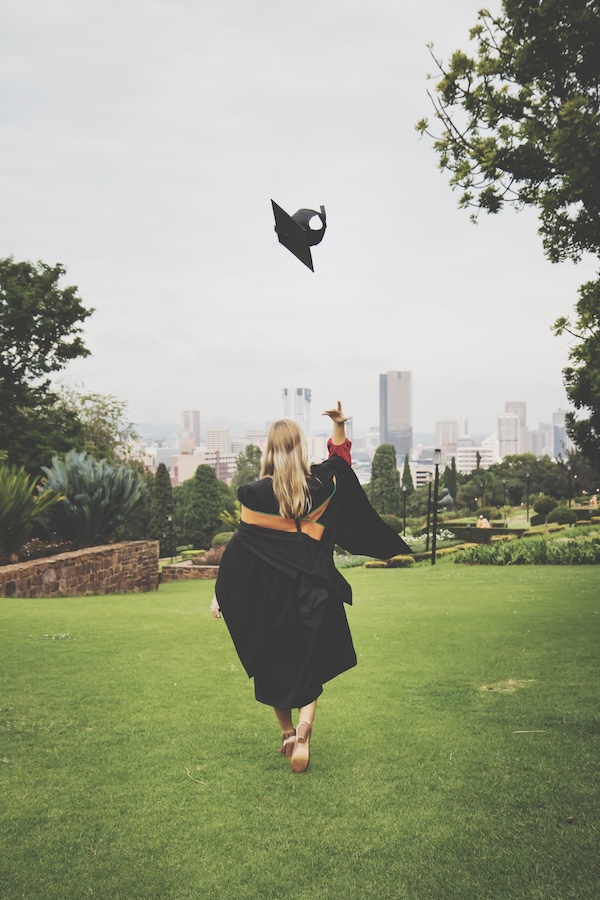
A striking graduation portrait set against the city skyline, where the urban landscape adds a modern touch to the image. The graduate stands confidently, with the tall buildings and architectural lines framing the shot beautifully. This photoshoot pose symbolizes ambition and a future full of possibilities, making it perfect for graduates stepping into the next chapter of their journey.
Relaxed Group Photo

A casual and cheerful group shot where graduates sit or stand on steps or in an informal setting. Rather than rigid poses, it highlights natural interactions like friends laughing, chatting, and leaning on each other to capture genuine camaraderie and warmth.
Diploma Huddle
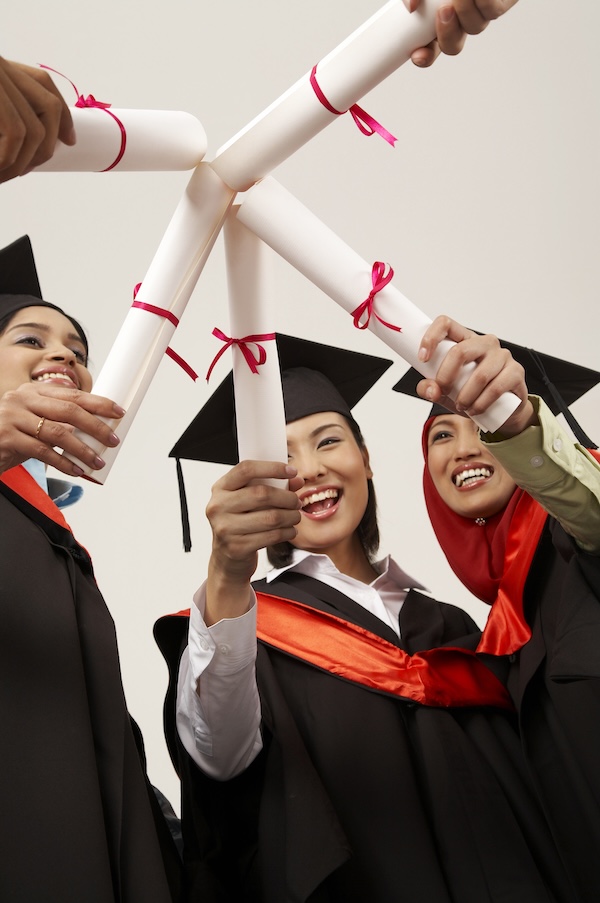
A lively group shot where graduates gather in a tight circle, extending their diplomas toward the center. This graduation photo pose creates a strong sense of unity and achievement, making for a powerful celebratory moment. Capture their expressions and interactions to highlight the joy and pride shared among the group.
High Five
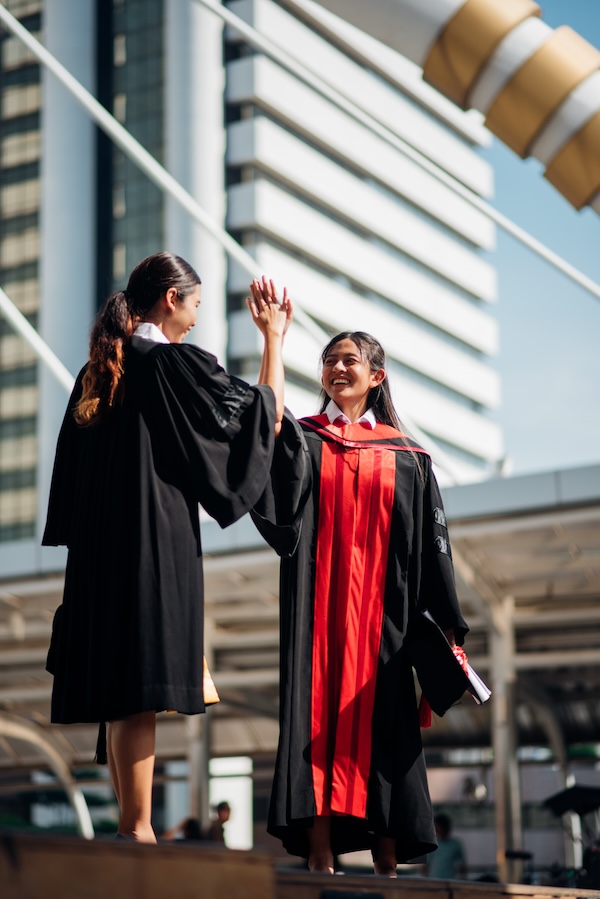
A joyful shot where friends exchange high fives while smiling brightly. This graduation pose captures excitement, friendship, and the shared pride of accomplishing something together. It works well outdoors or in hallways, highlighting natural interactions and celebratory energy.
Holding Diploma Scroll
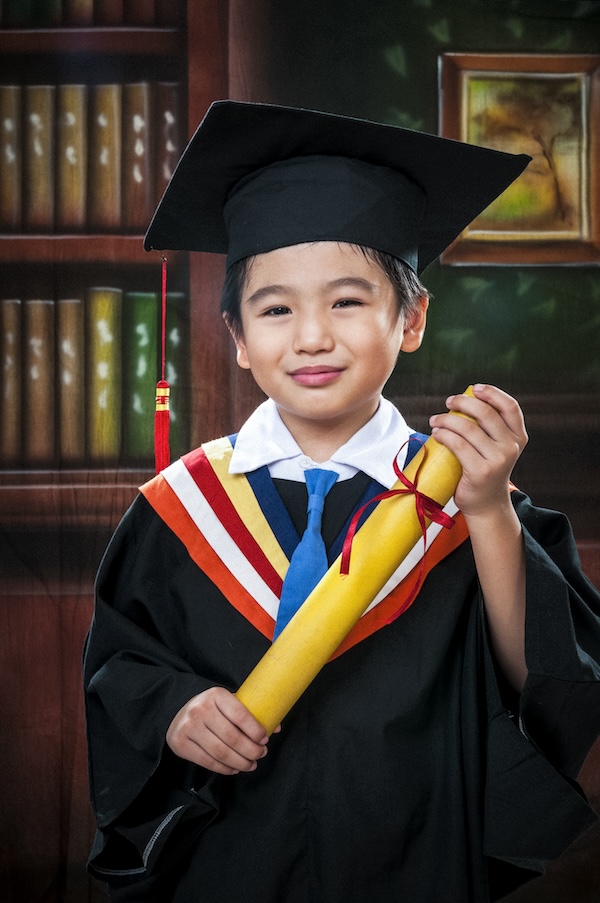
Have the graduate stand or sit while holding their diploma scroll prominently, paired with a big, proud smile. This classic photoshoot pose highlights their achievement and conveys confidence and joy, making it perfect for both formal and casual graduation portraits.
Tassel Show-Off
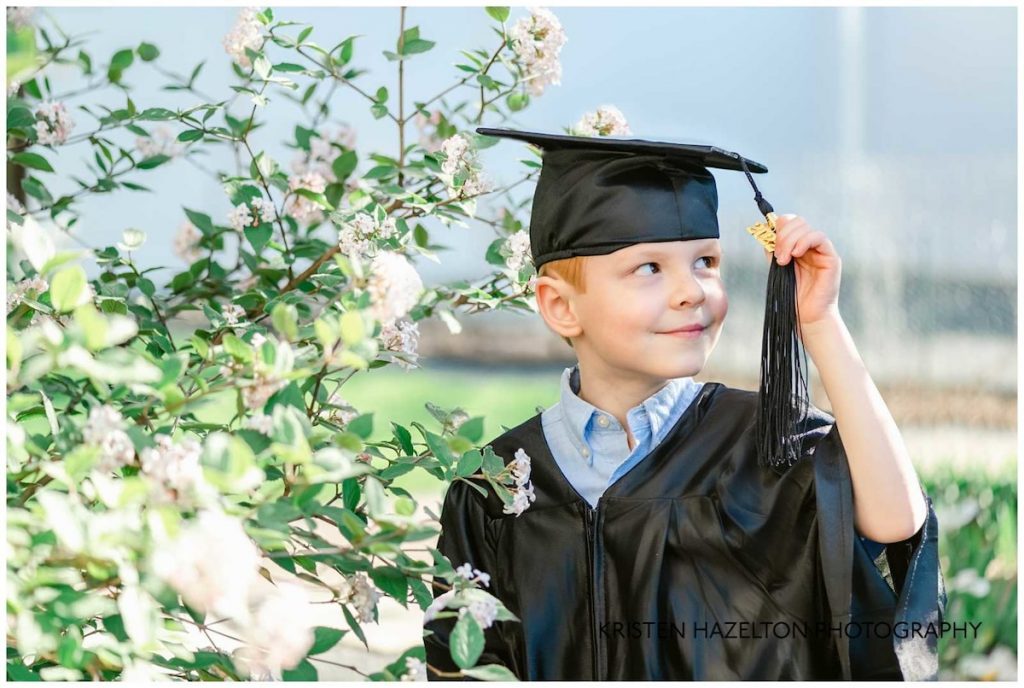
Have the graduate showcase their tassel by holding it, flicking it, or letting it swing playfully near their face. This fun pose emphasizes the graduation theme while adding personality and a lighthearted touch to the portrait.
Hands in the Air
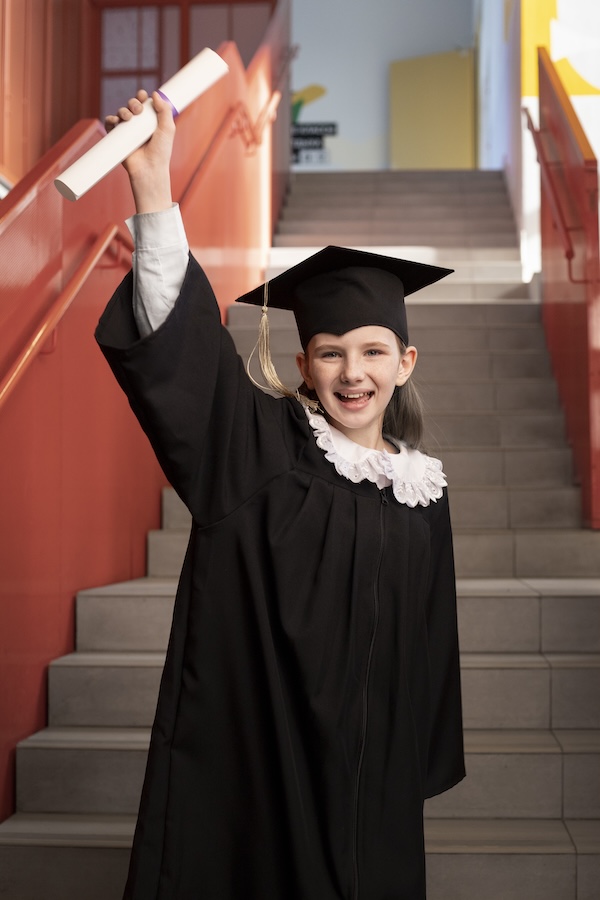
Capture the graduate raising both hands high in celebration, expressing genuine excitement and joy. This energetic pose conveys triumph and the thrill of accomplishment, making it ideal for lively graduation portraits.
Favorite Toy
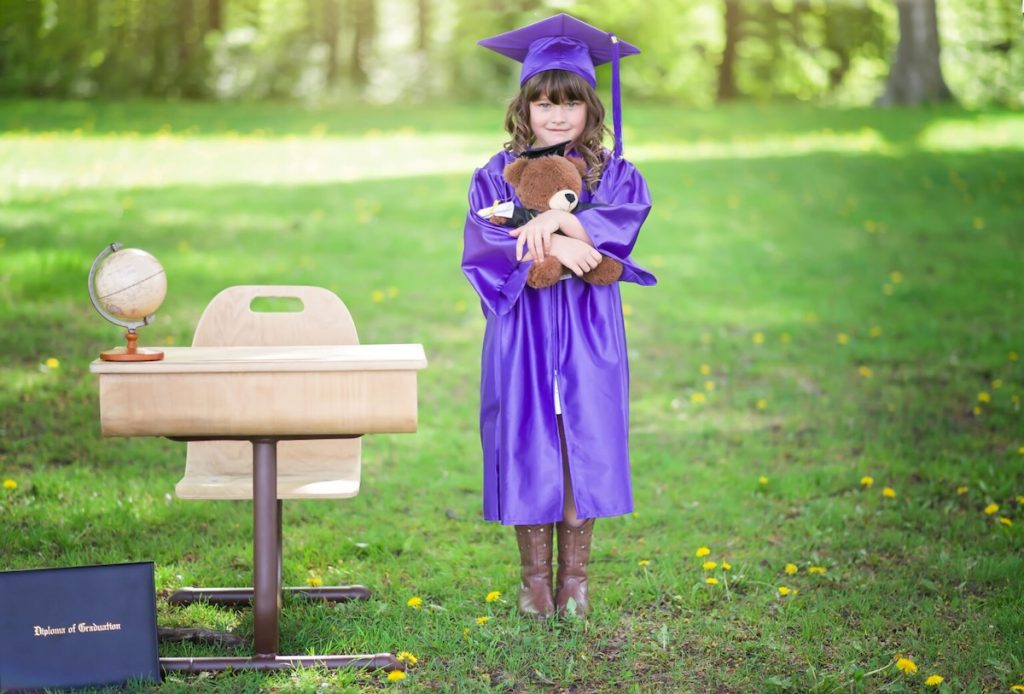
Have the graduate hold or pose with a cherished toy or personal item that reflects their personality or childhood memories. This graduation photo pose adds a heartfelt, personal touch that parents and family members will treasure, making the portrait uniquely meaningful.
Looking Through the Diploma
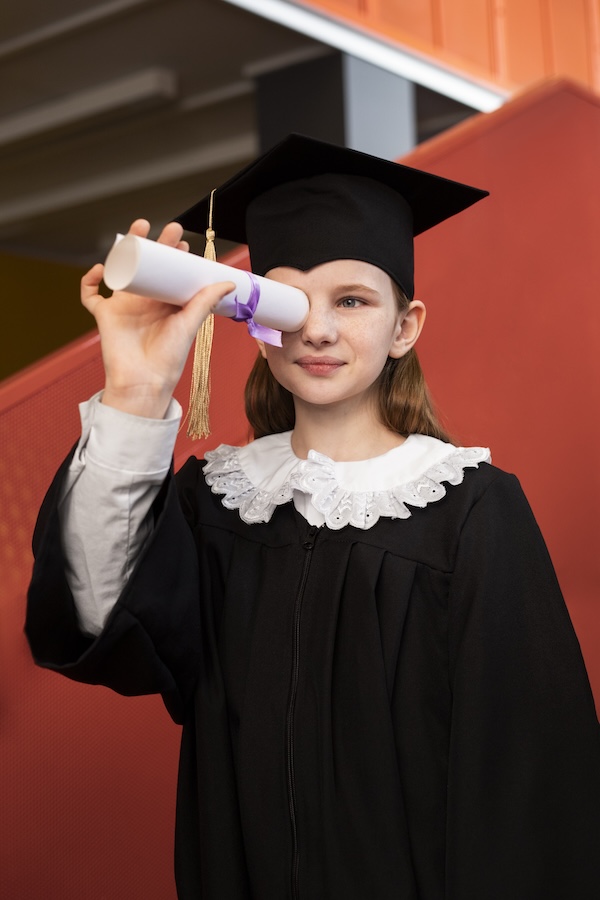
Have the graduate hold their diploma scroll up to one eye like a telescope, creating a playful and curious expression. This fun pose adds personality and humor to the portrait while still celebrating their achievement.
Playful Pose
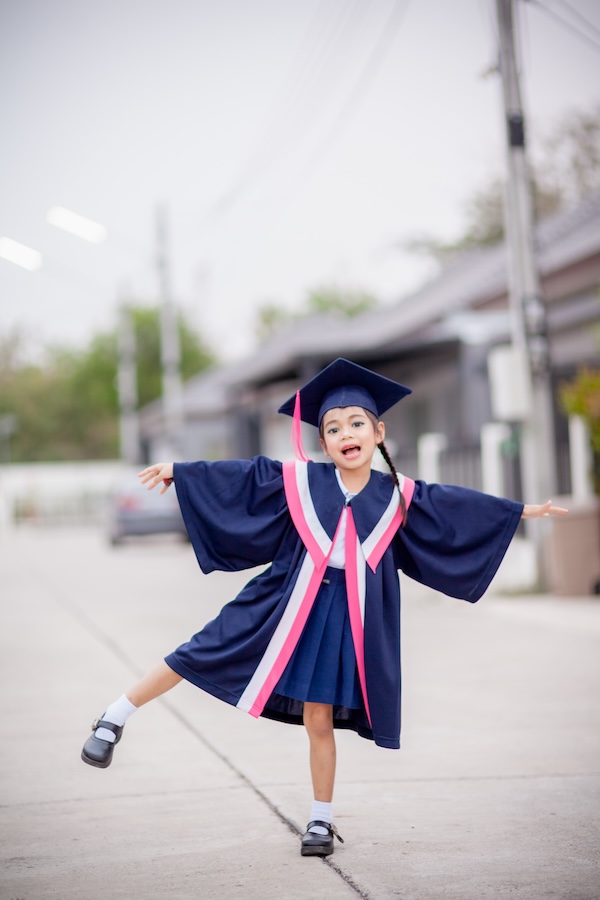
Have the graduate spread their arms wide, twirl, or strike a pose as if they’re soaring or pretending to be a butterfly. This lighthearted photoshoot pose adds movement and fun, capturing the joy and excitement of graduation day in a whimsical way.
Family Time
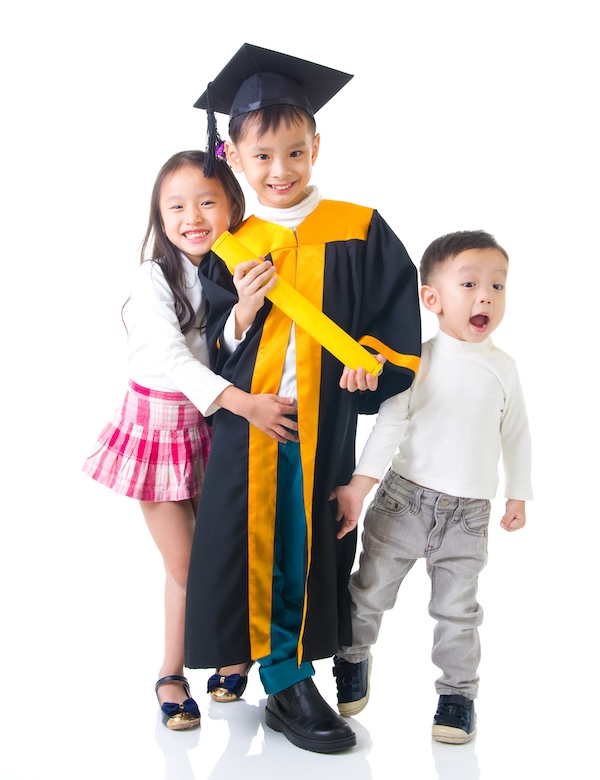
Capture sweet, candid moments of the graduate with their family, sharing hugs, laughter, or gentle interactions. This photoshoot idea highlights the support and love surrounding the graduate, making it especially meaningful and heartwarming for kindergarten or early school graduation shoots.
Silly Poses
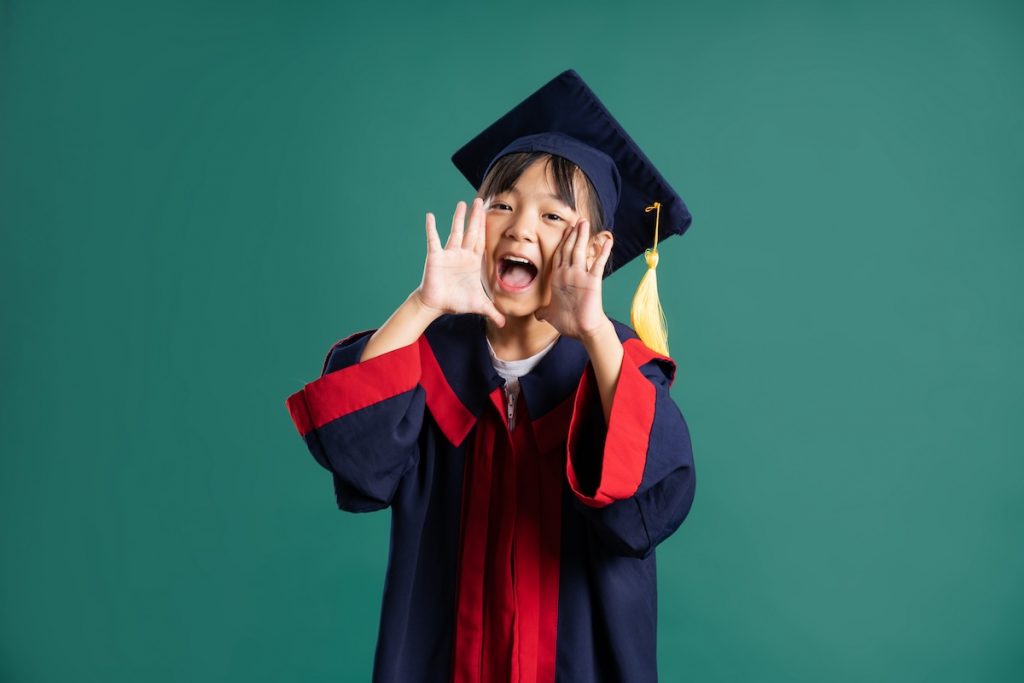
Encourage the graduate to make over-the-top facial expressions or playful gestures for a humorous, candid shot. This creative photoshoot idea brings out their personality and adds a fun, lighthearted element to the photo collection.
Jumping
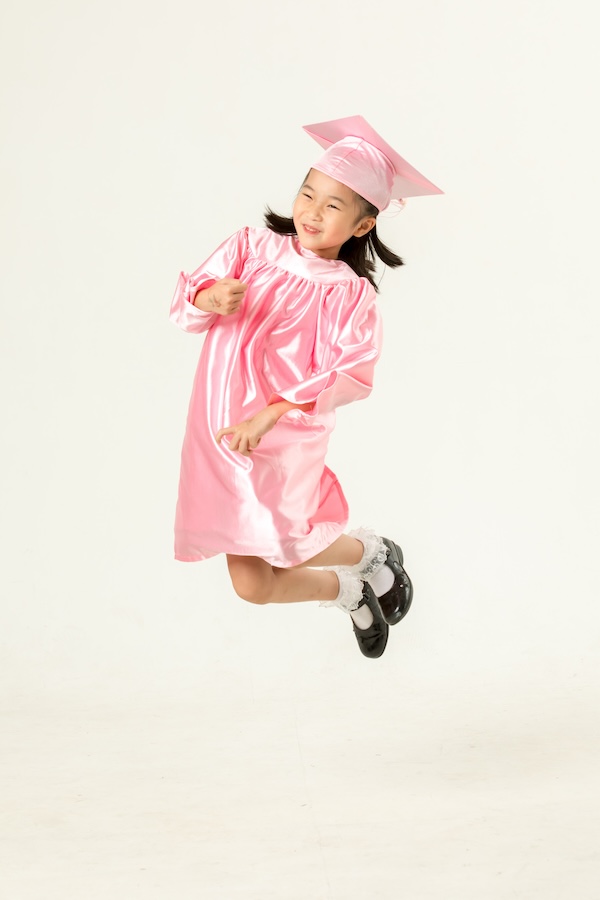
Capture the graduate mid-air as they jump, expressing energy, joy, and a sense of accomplishment. This dynamic photoshoot idea highlights excitement and celebration, creating a lively and memorable graduation portrait.
Framed With Architecture
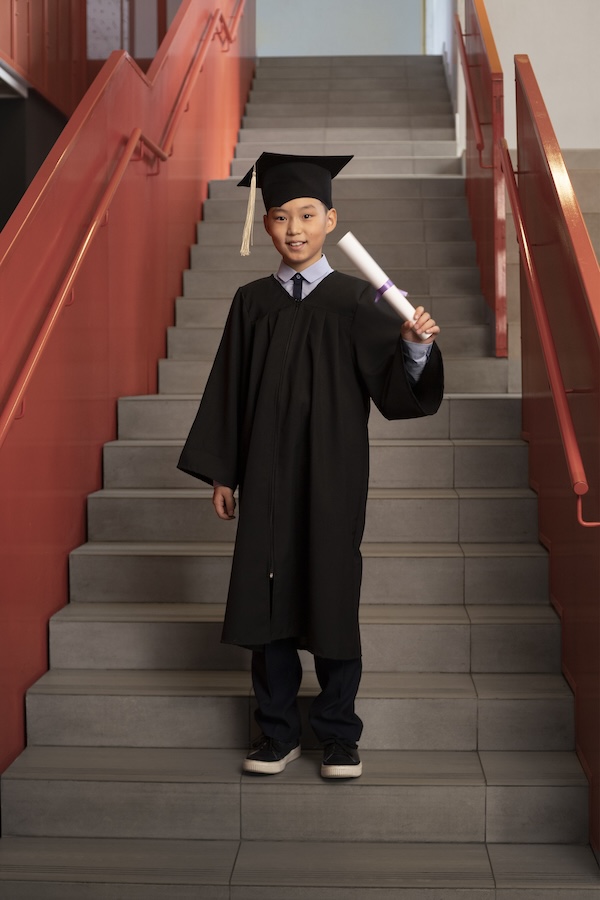
Use architectural elements like staircases, archways, or school entryways to frame the graduate within the shot. This graduation photo idea adds depth and structure to the portrait, creating a visually striking image that highlights both the setting and the graduate.
Low-Angle Cap Toss With Architecture
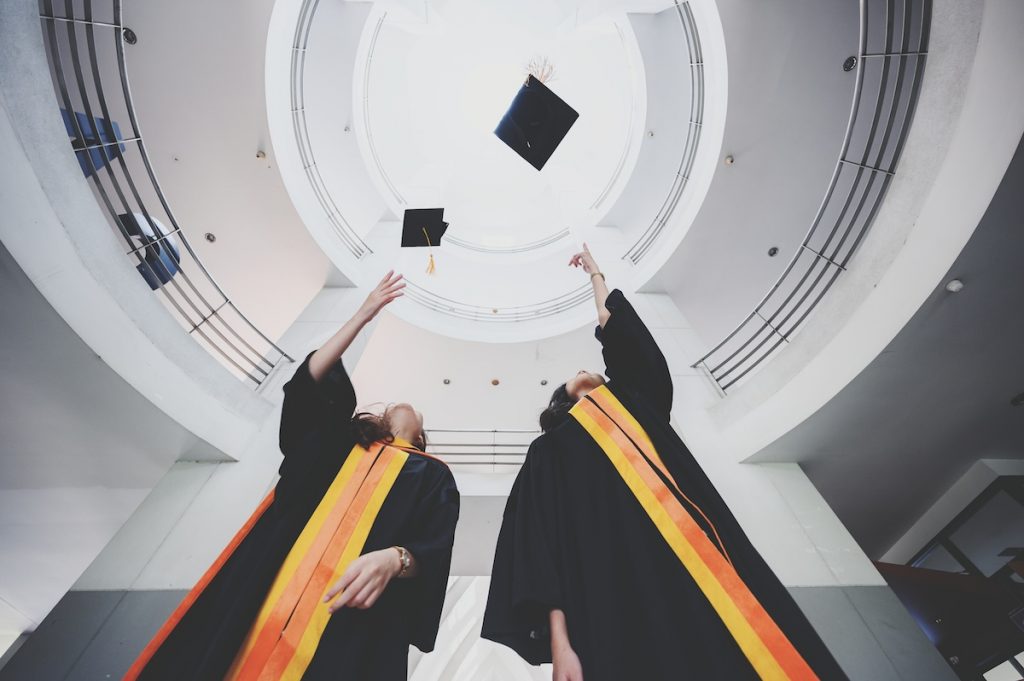
Shoot from a low vantage point, almost at ground level, while the graduate stands centered beneath a symmetrical structure such as an arch, colonnade, or building facade. As they toss the cap upward, the surrounding lines frame the action, drawing the viewer’s eye toward the cap at the peak of its flight. This angle emphasizes grandeur and symmetry, making the moment feel monumental.
Over the Shoulder
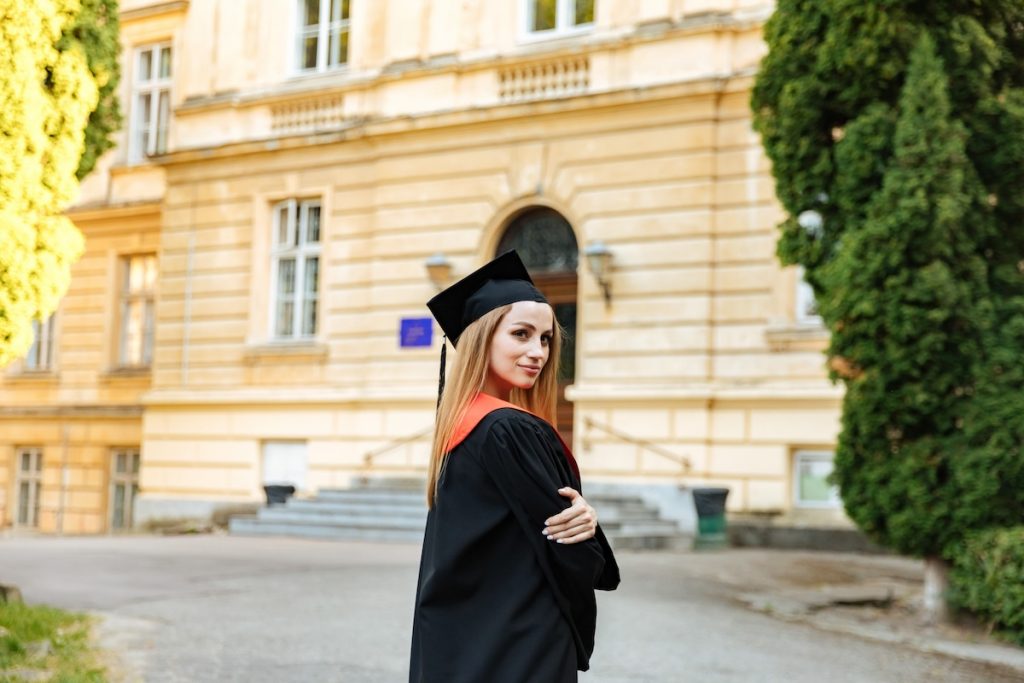
Have the graduate walk a few steps away, then turn their head back toward the camera with a soft smile or confident gaze. This graduation photo pose works beautifully along pathways, staircases, or hallways, especially when the gown flows naturally behind them. It captures a sense of reflection and anticipation, creating an elegant, timeless portrait.
Back View With Raised Fist
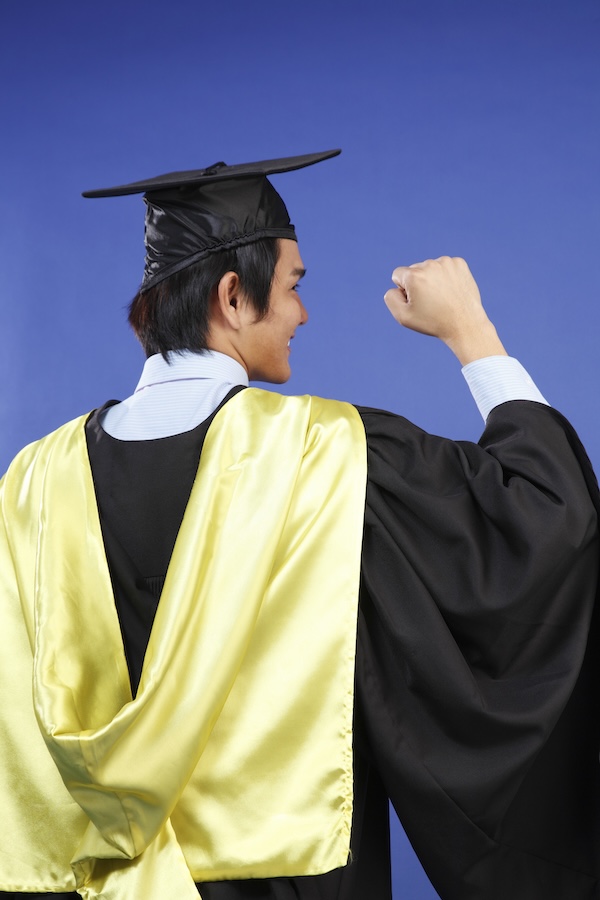
Photograph the graduate from behind as they look slightly to the side, raising a fist in the air. This graduation photo pose highlights the cap and gown from the back while capturing a powerful sense of accomplishment. It works well against open skies, school buildings, or even in the studio, creating a strong and uplifting image.
Group Candid Shot
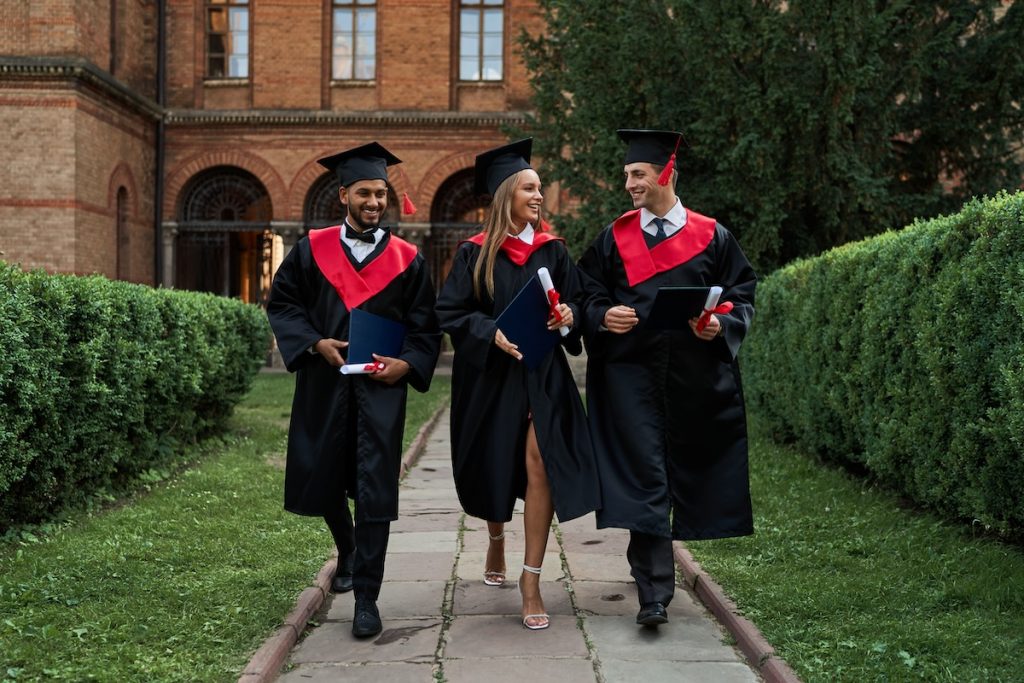
Capture a group of graduates walking side by side, naturally engaged in conversation. Encourage them to chat, smile, or laugh with each other as they move, creating a relaxed and genuine moment. This candid style works best along tree-lined paths, open courtyards, or hallways, giving the photo an effortless and joyful energy.
Classic White Background

Use a clean white backdrop to create a timeless, studio-style portrait. Have the graduate stand tall facing the camera, holding the cap or diploma neatly in front of them. Keep the lighting soft and even to highlight their features and attire. This simple setup puts all the attention on the graduate, making it perfect for formal prints or yearbook-style shots.
Casual Studio Shoot
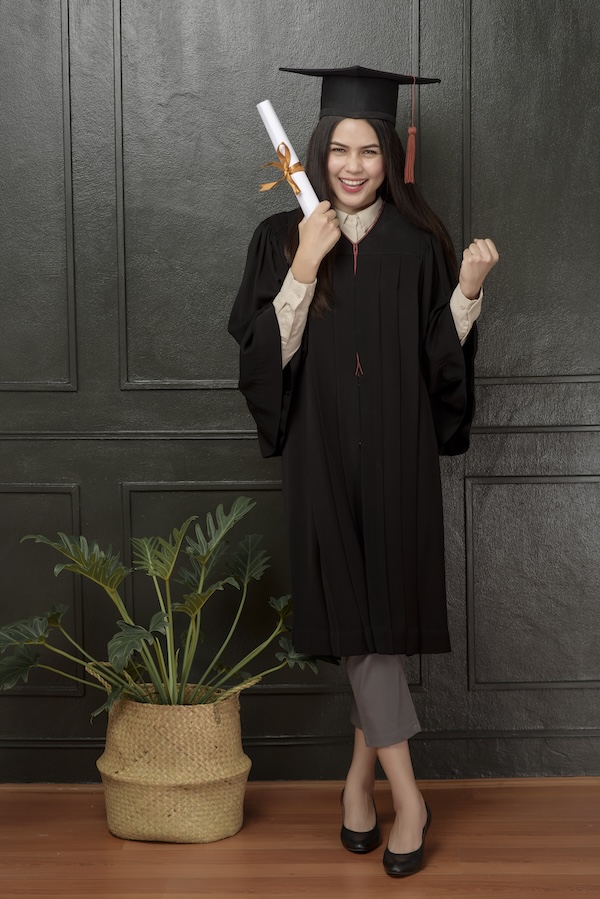
Choose a relaxed, colorful, or textured backdrop to create a warm and approachable vibe. Incorporate props such as house plants or even an empty chair, and encourage playful or candid poses—like holding the diploma with pride. This setup highlights their personality and makes the portraits feel lively and unique.
Creative and Fun Edit

Capture the graduate in a joyful celebratory stance like jumping, tossing the cap, or striking a victory pose, then enhance the image with playful edits. Add confetti overlays, light flares, or motion blur to emphasize movement and excitement. You can also experiment with vibrant color grading or double exposure effects for a dynamic, eye-catching finish that gives the graduation photo a festive, modern vibe.
Taking Off Graduation Cap
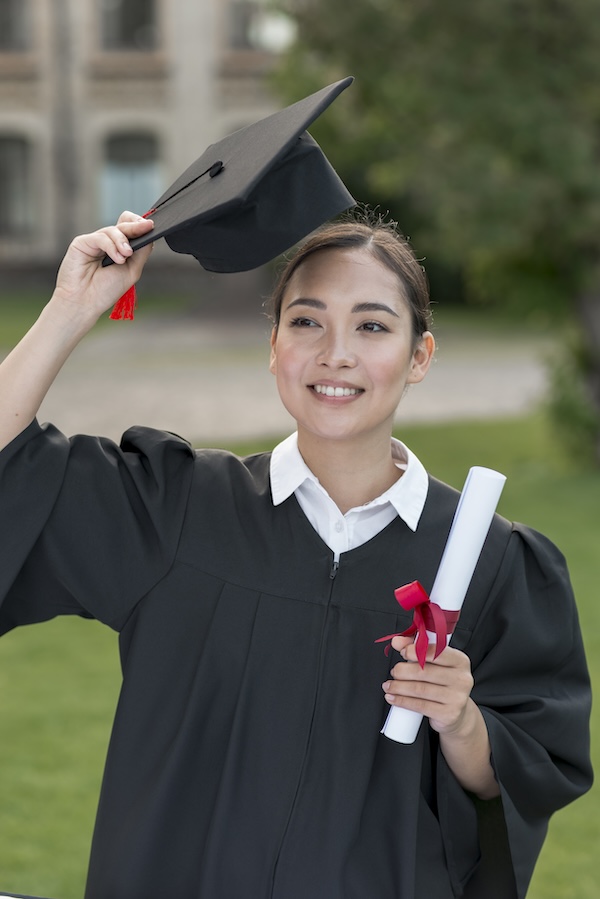
Have the graduate hold their diploma proudly in one hand while lifting the graduation cap with the other. This graduation photo pose can be playful or elegant depending on their expression. It’s a great way to show both key symbols of graduation in one frame, and works well in studio settings, outdoor locations, or in front of school landmarks.
Funny Pose

Encourage the graduate to let loose and show their playful side. They can strike an exaggerated superhero stance, pretend to trip while holding the diploma, balance the cap on their nose, or make a goofy face at the camera. Using simple props like oversized glasses, confetti poppers, or playful signs can add to the humor. This graduation photo idea breaks away from traditional portraits and captures their personality in a lighthearted way.
Video Call Celebration

Have the graduate hold up their phone as if they’re on a video call with family or friends, showing off their cap, gown, and diploma to the screen. Capture their joyful expression as they wave, laugh, or proudly display their achievement. This pose reflects modern celebrations and is perfect for graduates sharing their milestone virtually with loved ones.
Gown Flying in the Wind
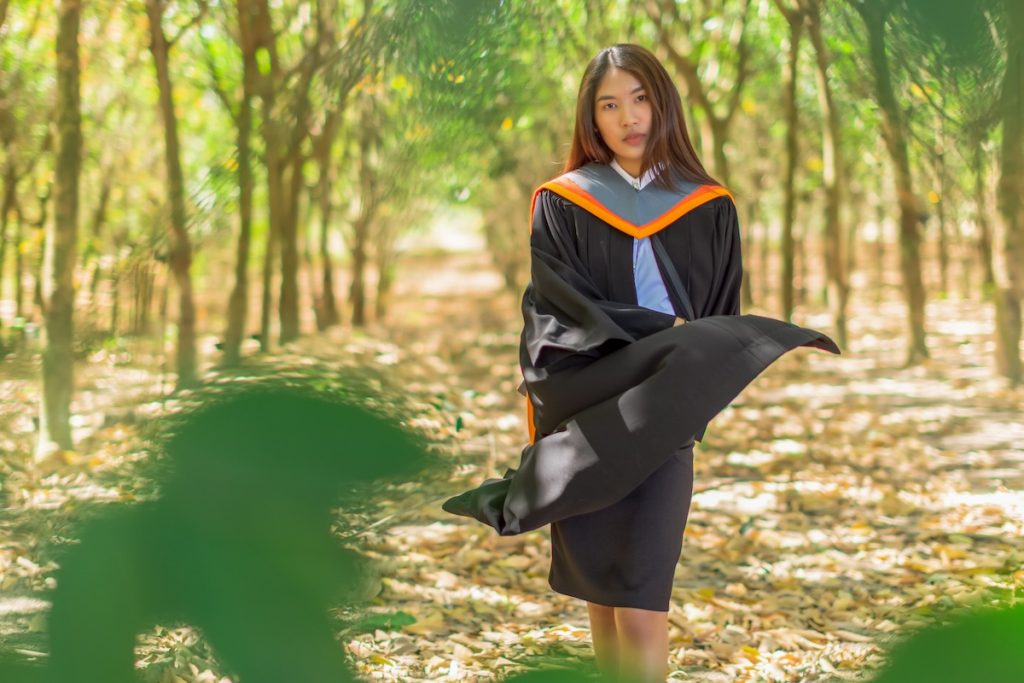
Photograph the graduate outdoors in a natural setting such as a tree-lined path, park, or open field. Have them stand or walk while the wind catches their gown, creating a flowing, dynamic effect. If there’s no natural breeze, use a fan or have someone give the gown a quick lift just before the shot. This graduation pose captures movement, freedom, and a sense of stepping into the future.
Helping Each Other Get Ready
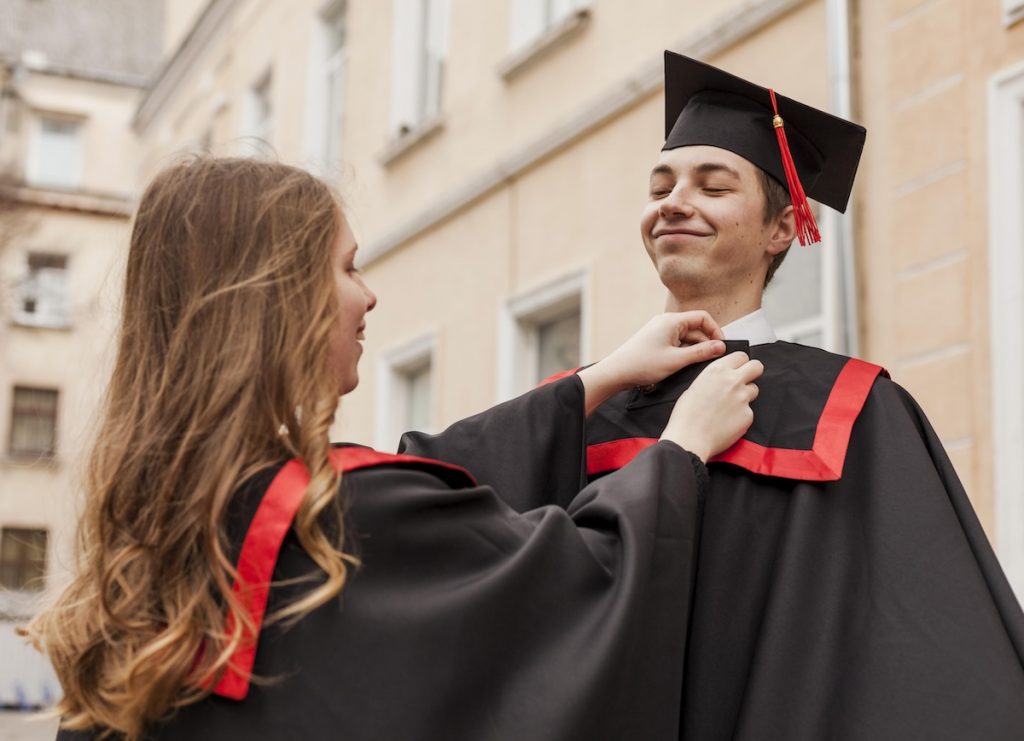
Capture a candid moment of graduates helping each with their outfits like adjusting caps, straightening gowns, or fixing tassels. This behind-the-scenes pose highlights friendship, teamwork, and shared excitement before the ceremony. It works beautifully in hallways, locker areas, or near mirrors, adding warmth and authenticity to the graduation story.
Leaning on Leading Line
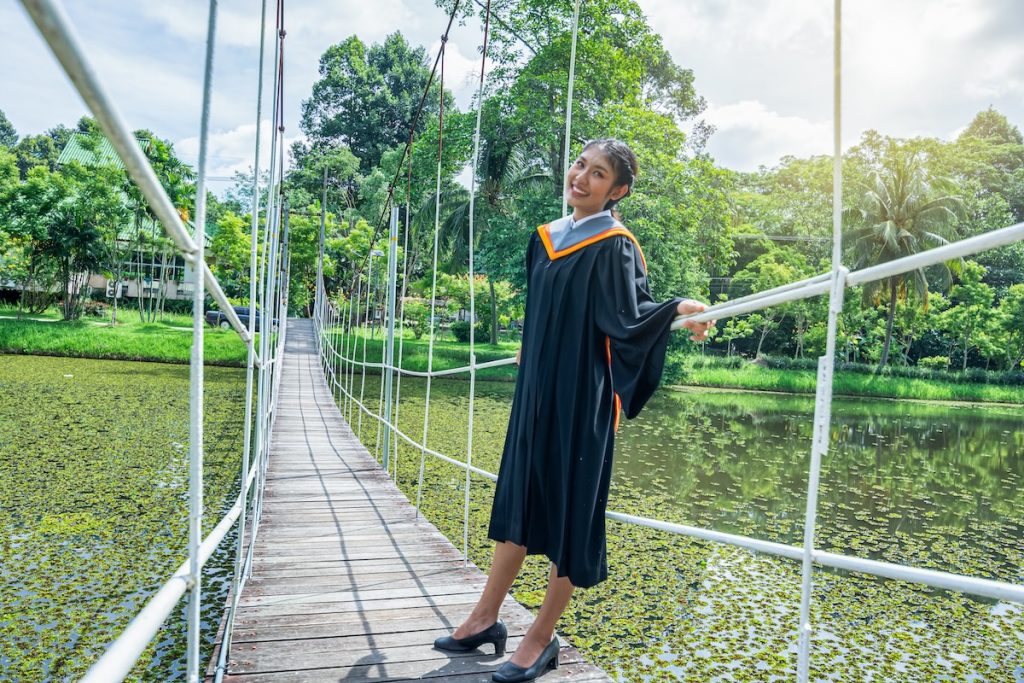
Position the graduate along a strong leading line such as a railing, fence, corridor, or pathway. Have them lean casually against it while looking toward or away from the camera. The leading line naturally draws the viewer’s eye toward the graduate, creating a clean and visually striking composition. This graduation photo idea works especially well in architectural settings or outdoor spaces.
Robe Off, Holding Diploma
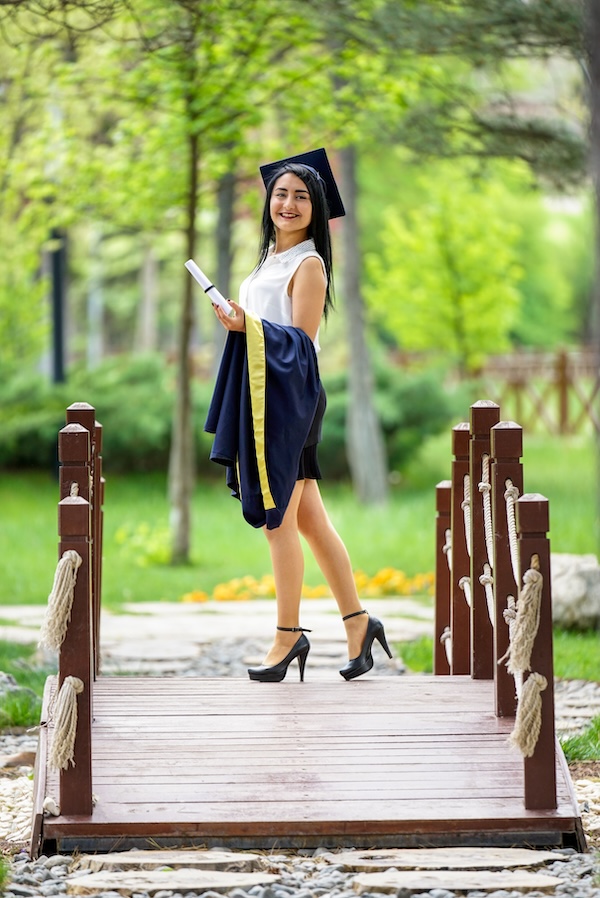
Have the graduate remove their gown and drape it casually over one arm while holding the diploma proudly in the other hand. Keep the graduation cap on to maintain the celebratory look. This pose gives a relaxed, end-of-ceremony vibe which is perfect for showing personality. It works well in open outdoor spaces or against simple backdrops.
Classic Bouquet Pose
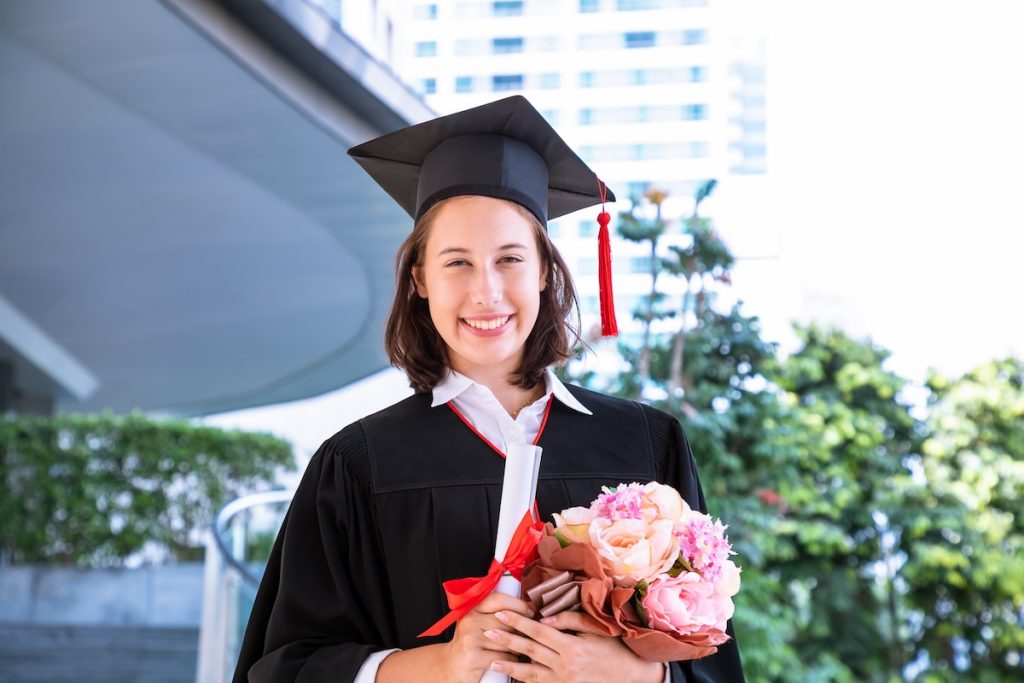
Have the graduate hold a bouquet or a single flower while wearing their full graduation attire. They can cradle the flowers in front for a classic portrait, hold them to the side for a more relaxed pose, or lift them slightly toward the camera for a playful touch.
Back View with Diploma and Chalkboard
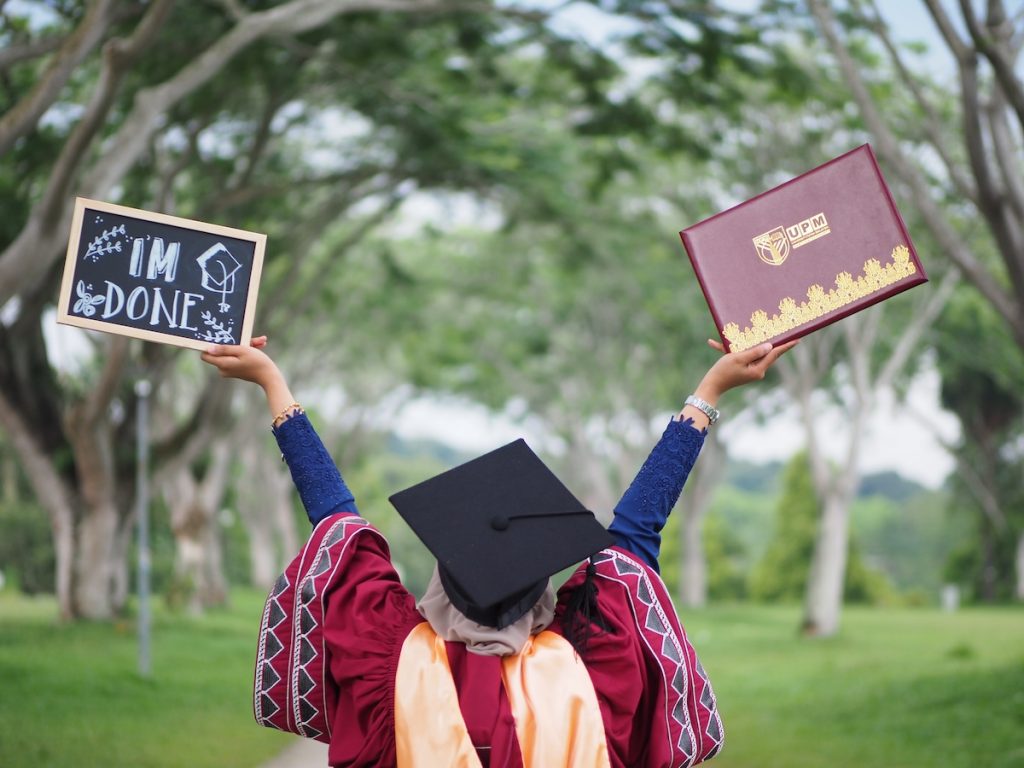
Photograph the graduate from behind while they hold the diploma in one hand and a small chalkboard sign in the other with a fun message like “I’m Done,” “Finally,” or “On to the Next Chapter.” The cap and gown from the back create a strong graduation silhouette, while the chalkboard adds a personal and playful touch. This graduation photo idea works beautifully outdoors or in front of meaningful school landmarks.
Low-Angle Cap Toss
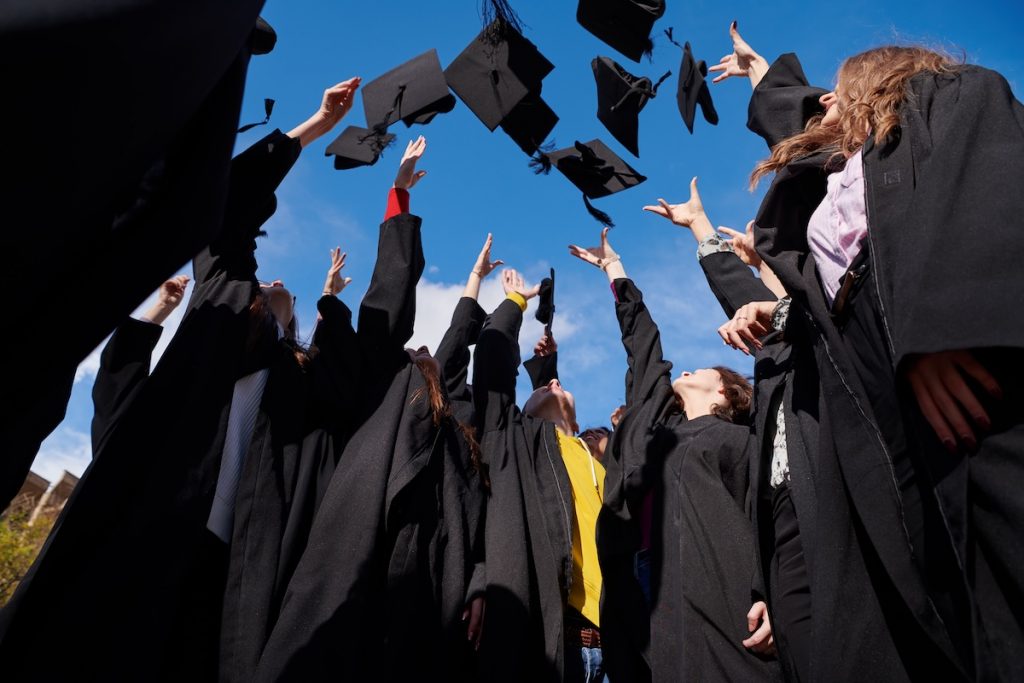
Position the camera close to the ground and angle it upward to capture graduates tossing their caps into the air. This perspective emphasizes the height of the toss and makes the caps stand out dramatically against the sky or surrounding architecture. It adds a sense of grandeur and excitement, turning a classic moment into a powerful, cinematic shot.
Group Cap Toss
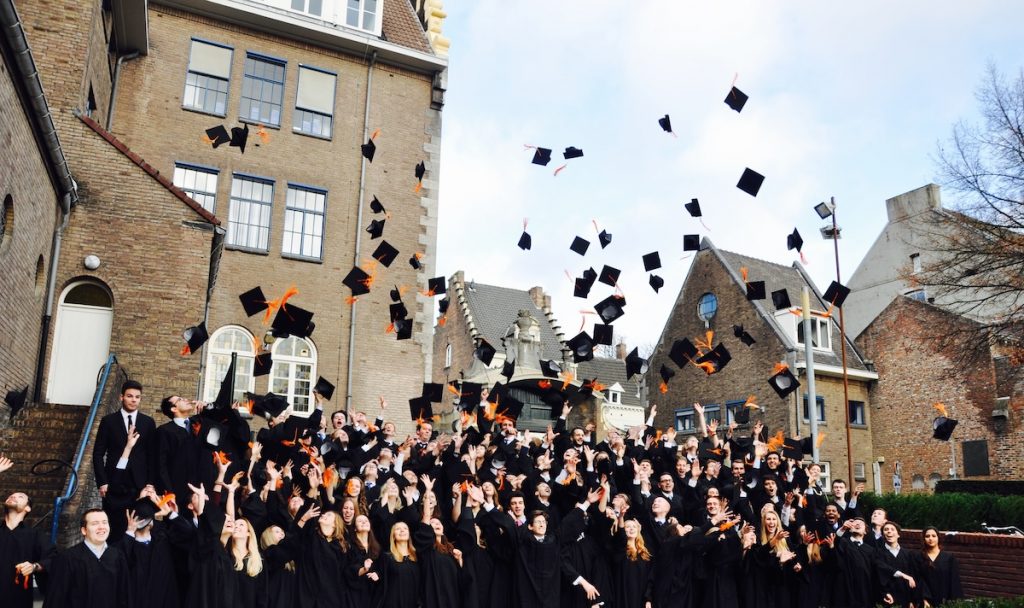
Gather the entire graduating class or batch in an open space and have everyone toss their caps at the same time. Capture the moment from a slightly wide or elevated angle to include the whole group and the flurry of caps. This graduation photo idea radiates collective joy and creates a powerful, unforgettable image that symbolizes the end of a shared journey.
Cheerful Walk
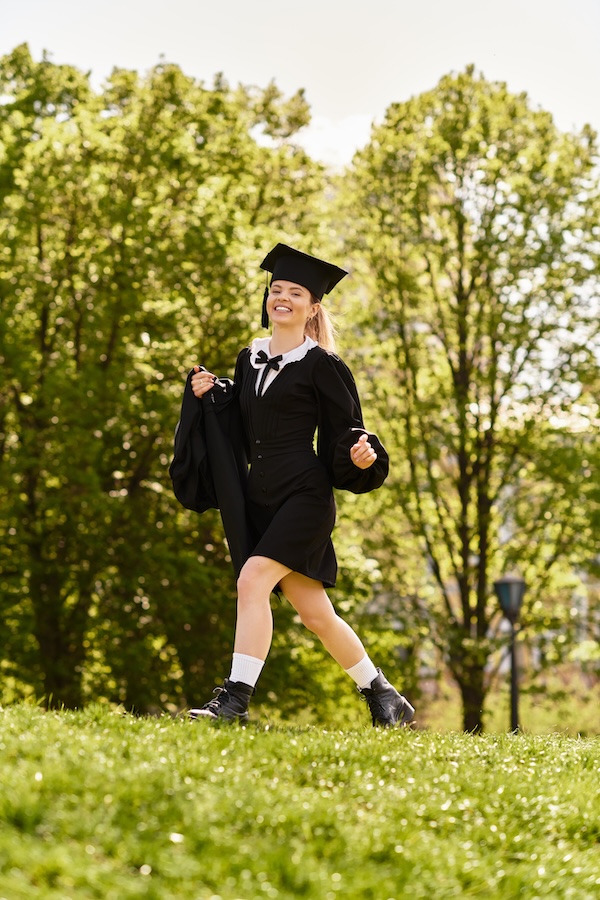
Have the graduate hold their robe loosely in one hand while walking with a relaxed stride. Encourage a natural smile and light movement to capture a carefree, post-ceremony vibe. This graduation pose works well outdoors or along open walkways, highlighting both their joy and the symbolic “end of the journey” moment.
Silhouette Between Architecture
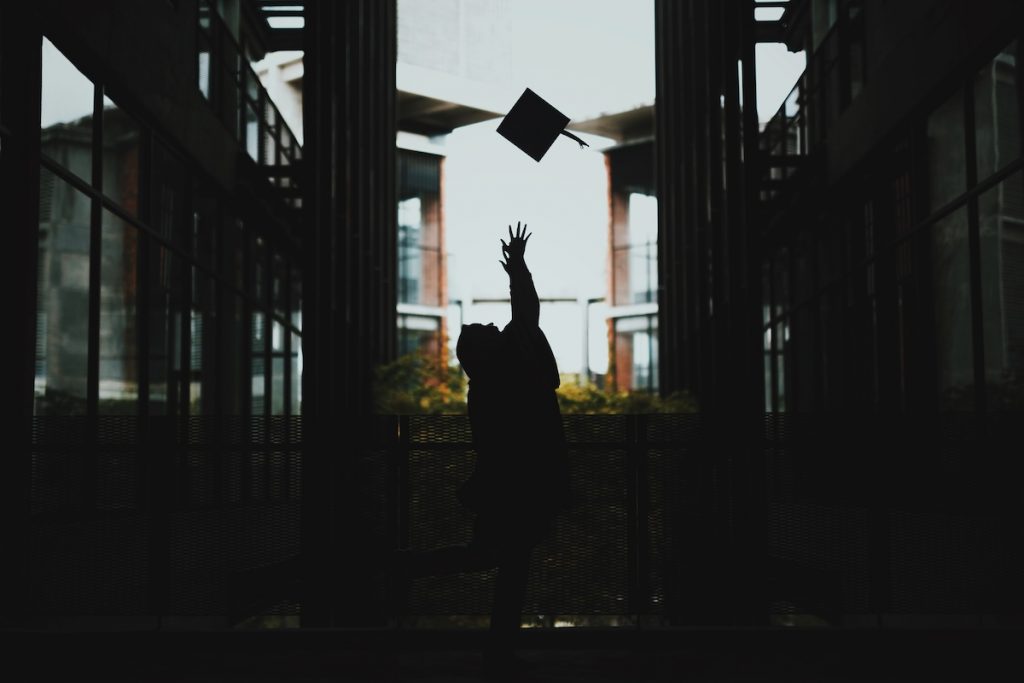
Position the graduate between two striking architectural features—pillars, an archway, or a school gate—ideally at sunset or with strong backlighting. Capture their silhouette as the graduation cap soars into the sky, framed by the structure. This creates a clean, dramatic outline while highlighting the celebratory moment.
Universal Posing Tips
When posing graduates of any age, try to avoid stiff or rigid positioning. Encourage small, natural movements such as shifting weight slightly, adjusting posture, or turning the shoulders to create a more relaxed look. Keeping the hands occupied helps prevent awkwardness, so suggest holding a diploma, a bouquet of flowers, or lightly grasping the edge of the gown.
For more posing tips and ideas, check out our guide for senior photos. Many of the same tips apply for graduation photography.
Whenever possible, use natural light to keep the look soft and flattering. However, be mindful of the cap’s brim, which can cast shadows across the eyes. Adjust the subject’s position or your shooting angle so that their face remains well-lit. Before taking each shot, check that gowns and caps are straight, smooth, and neatly positioned, as small adjustments can make a significant difference in the final image.
Gear and Setup Suggestions
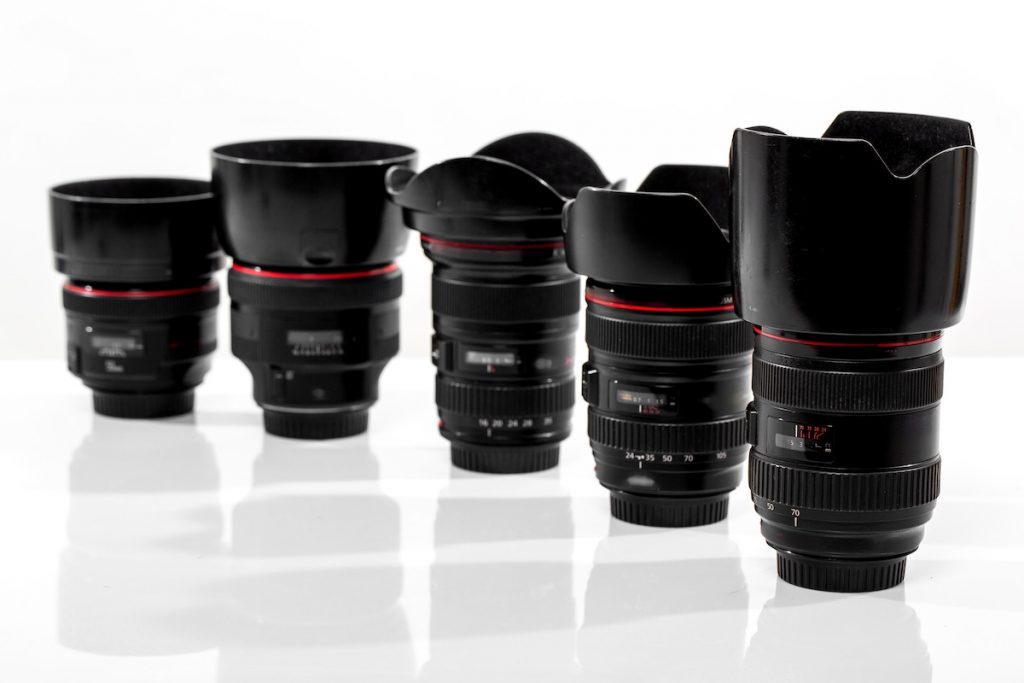
The right gear can make all the difference in ensuring you capture graduation day with both clarity and flexibility. Because the event moves quickly and covers a range of environments from dimly lit auditoriums to bright outdoor gathering spaces, versatility should be your top priority.
A reliable DSLR or mirrorless camera body with fast autofocus is essential. Look for one that performs well in low light, as indoor ceremonies often prohibit flash photography. Pair it with a selection of lenses that allow you to adapt to different shooting conditions. A 70–200mm telephoto lens is perfect for stage shots where you need to stay at a distance but still capture expressions clearly. A 24–70mm lens offers excellent flexibility for group photos and environmental portraits, while a prime lens such as a 50mm f/1.8 is ideal for shallow depth-of-field shots that highlight a graduate against a softly blurred background.
A sturdy but lightweight monopod can help stabilize long-lens shots without restricting your mobility. If you expect extended outdoor sessions, a reflector can be invaluable for softening harsh sunlight during midday portraits. For those working in multiple locations, a compact camera bag with quick-access compartments will let you switch gear efficiently without missing key moments.
Memory cards and batteries deserve special attention. Bring more than you think you will need, as the rapid pace of the day leaves little room for recharging or offloading files. Keeping a few extra cards and fully charged batteries within easy reach ensures you can keep shooting without interruptions.
Lighting choices will depend on the venue rules and your personal style. Some indoor graduation ceremonies limit flash use, so knowing how to work with available light is critical. For outdoor portraits, natural light is often your best friend, but an off-camera flash or LED panel can help fill shadows. Positioning your subjects so the soft light falls gently on their faces and avoiding hard overhead light will make a noticeable difference in the final images.
Finally, consider your own comfort. You’ll be moving constantly, often over several hours, so wear supportive shoes and carry only the gear you truly need. A well thought out setup keeps you agile, prepared for every situation, and able to focus entirely on the moments unfolding in front of you.
Instant Photo Delivery and Sales With Honcho
Graduation is a high-energy, high-volume event. You may be shooting thousands of images in a short time, with multiple families and graduates eager to see the results. Traditionally, these photos might take days or even weeks to organize and deliver, but modern tools can make this process almost instant.
One of the most effective solutions for this is Honcho, a real-time photo delivery platform designed for fast-paced events like graduation ceremonies. Unlike traditional online galleries, Honcho helps you deliver images as soon as they are taken. Families can receive their graduate portraits within seconds, while the excitement of the day is still fresh.
Setting it up is simple. Before the event, you create a gallery in the Honcho app and generate a unique QR code. This code can be shared in school emails, printed programs, or displayed at the venue. When graduates visit the gallery, they can upload a selfie and Honcho’s face recognition matches them to their photos automatically. No scrolling through endless galleries to find their own photos—just a private collection of the moments they care about. If they visit the gallery before the convocation, they can register their selfies and Honcho automatically notifies them by email or WhatsApp, as soon as their photos are uploaded.

From your perspective, Honcho doesn’t require any change to your workflow. You can tether your camera to the app and upload from camera to cloud while you shoot. The system sorts and organizes the images, and you can apply editing presets automatically or have an assistant live edit your photos during the shoot. This allows you to deliver polished images on the spot, even during the busiest parts of the day.
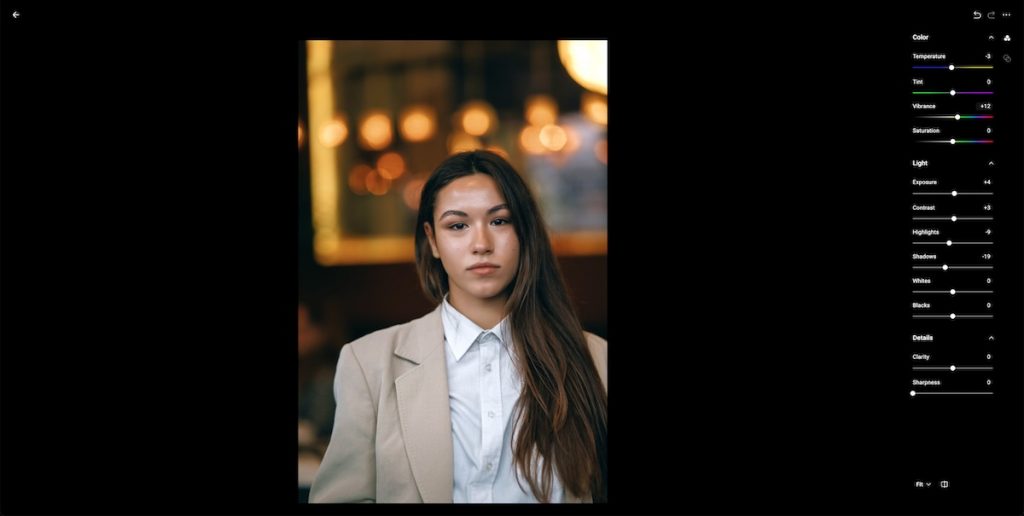
Honcho helps you earn more from every shoot by selling your photos. And because the photos are delivered live, at the height of the excitement, you capture sales when families are most eager to buy. Everything runs automatically while you shoot—just add an online store with one click and make your gallery instantly shoppable.
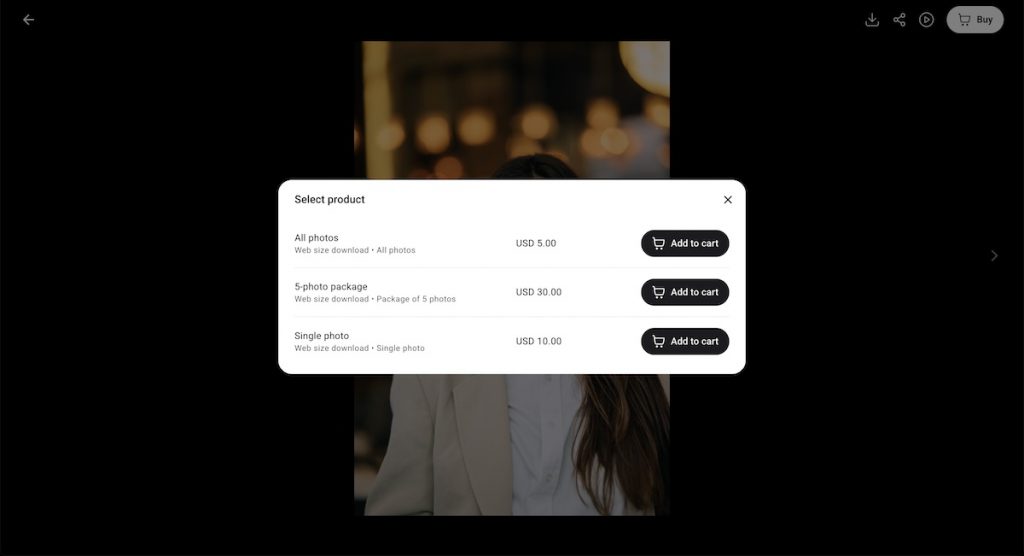
The advantages extend beyond instant delivery and sales. The gallery displays your branding and contact information, so when proud families share it on social media, they’re also promoting your work to a broader audience. Over time, this kind of organic exposure can lead to more bookings, not just for graduations, but for other school or family photography work as well.

Honcho offers customizable lead capture tools to help you generate more leads. Collect emails, feedback, or interest in future sessions during or after graduation day, and grow your network effortlessly.
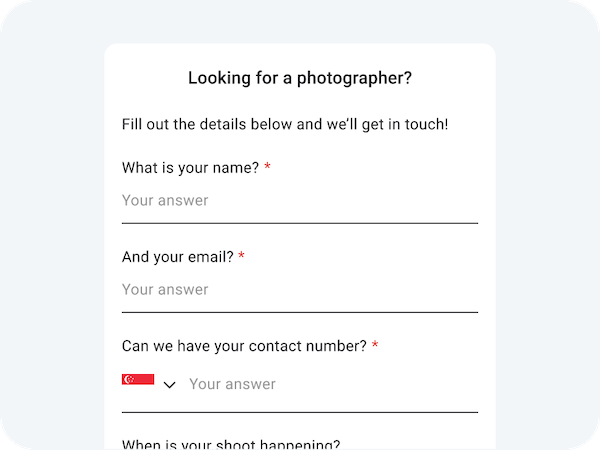
Honcho also provides performance analytics after the event. You can see how many people visited your gallery, how many face searches were made, and how often your profile was viewed. These reports can be valuable in showing schools or universities the reach and efficiency of your service.

By incorporating Honcho into your workflow, you can focus on capturing the defining moments of graduation day while delivering a modern, seamless experience that families remember just as fondly as the photos themselves.
Wrapping Up
Graduation photography is about capturing the pride, excitement, and sense of achievement that define this milestone. From a formal cap-and-gown portrait to a candid laugh with friends or a stage photo during the ceremony, these images become treasured keepsakes for years to come. By blending classic poses with creative touches, graduation photographers can deliver a gallery that feels both timeless and deeply personal. The goal is simple: preserve the graduate’s big day so they can relive its emotions every time they look at their photos.

